David E. Grogan's Blog, page 6
April 20, 2021
Master Sergeant Jay Cyril Mastrud, U.S. Air Force – Navy First, Air Force Always
The road through life is never straight and rarely fair. Some begin their journey with a supportive family and an adequate income, giving them a head start along their way. Others are not so fortunate, facing seemingly insurmountable hurdles that conspire to keep them from continuing. Yet they drive on, navigating around the hurdles until they reach a place where they can look back with pride at what they have accomplished. Such is the case for Master Sergeant Jay Cyril Mastrud, U.S. Air Force. Despite the hurdles placed in his path, Jay never gave up. He went from his roots in the Navy to become a successful and respected leader in the Air National Guard. He is a strong advocate for not trying to go it alone, but for reaching out to others for help when the hurdles seem too high. This is his story.
Jay was born in 1969 and raised in Cicero, Illinois, just thirty blocks north of busy Midway Airport in Chicago. The town was part of Chicago’s industrial backbone and home to such companies as General Electric Hotpoint and Western Electric. Jay’s father drove a catering truck selling food to the many workers in the local area factories, and his route took him through some rough areas. His father was robbed on more than one occasion and even shot at on the job, making his work situation very stressful. Not knowing how to deal effectively with the danger, and having spent some time in jail and suffered trauma as a child, he brought his stress home and created a chaotic environment for Jay and his mother and siblings. Making matters worse, Jay’s mother, who immigrated from Europe, struggled with drug and alcohol abuse and unprocessed trauma of her own.
Jay’s family situation made him want to spend as little time at home as possible. Growing up, he did the kinds of things most kids in his neighborhood did, playing baseball and tackle football (without pads), watching trains go by on the nearby railroad tracks, and sneaking into the local racetrack with friends to watch the races. He had a tough time at school, not because he wasn’t smart enough, but because his home life made it difficult to stay focused or do homework. As a result, he took the vocational path through high school. This offered many advantages, particularly because his school, J. Sterling Morton High School East, was surrounded by factories in need of workers with a trade. When the school offered Jay the opportunity to learn about electronics, he found a hands-on subject he liked that could help him escape the chaos at home.
When it came time for graduation in June of 1987, Jay’s father gave him three choices. He could join the military, go to college, or get a job and pay rent. While Jay appreciated the clear choice his father offered, it was really no choice at all. College didn’t seem like a viable option at the time and there was no way he could continue to live at home – he had to get out of the house just like his older brother had done. That meant joining the military. Although his brother, Steven Grimes, had been a Marine, and Jay had a friend who wanted him to go Air Force, it was the Navy that caught Jay’s attention. So much so, that he remembers the recruiter’s name to this day, Petty Officer Second Class William Carmean, who worked out of the Berwyn, Illinois, recruiting office.
Jay’s only request was that he be assigned some place out west. Petty Officer Carmean said he could guarantee Jay a West Coast assignment, but could not guarantee the type of work Jay would be doing, known in the Navy as a “rate”. That would be up to the needs of the Navy wherever Jay was ultimately assigned. That was good enough for Jay and he signed his enlistment papers.
Jay reported to the Chicago Military Entrance Processing Station, or “MEPS”, in the summer of 1987 to begin his enlistment. After passing a physical exam and taking the oath of enlistment, he was officially a Navy recruit. Together with several other Navy recruits who reported the same day, Jay boarded a Chicago area Metra commuter train bound for boot camp at Naval Station Great Lakes, just of few miles north of Chicago. He remembers his assignment as if it were yesterday: Company 396, 13th Division, Compartment D1, Rack 1106. He also remembers boot camp was a tough transition for him as he went in a little overweight, which garnered him extra attention and lots of additional pushups. He managed to maintain a positive attitude throughout, which helped him successfully navigate the many challenges he faced.
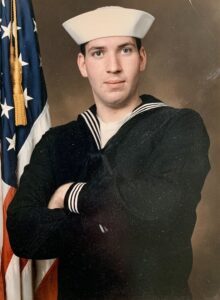 Jay Mastrud at Boot Camp
Jay Mastrud at Boot CampWhile at Great Lakes, Jay and the other recruits had the opportunity to meet with detailers, who were the Navy officials determining where the recruits would be sent for their first duty station. When it came Jay’s turn, the detailer told him his Armed Services Vocational Aptitude Battery (ASVAB) scores in the electronics field were off the chart. Suddenly, his vocational training in high school was paying off. The detailer gave him the choice of three electronics ratings to work in, and Jay chose the Aviation Fire Control Technician rate, abbreviated as “AQ”. This meant the Navy would train Jay to maintain and repair the advanced electronics weapons systems on aircraft deployed on ships around the world. He saw this as an exciting opportunity.
Before Jay could work on the equipment in the fleet, he had to go to another Navy school to learn his new trade. That happened after he graduated from boot camp on November 9, 1987. He left Naval Station Great Lakes and headed to O’Hare Airport in Chicago for his first flight in an airplane. He flew to Memphis, Tennessee, and then took a shuttle to the Naval Air Technical Training Center in Millington, Tennessee. There he attended an “A” school, learning the fundamentals of his new AQ rate. As he loved working on electronics, he did well and enjoyed his time there. One incident, however, had a lasting impression on him. When he was standing fire watch one night in the barracks, one of the sailors living there slit his wrists with music from Led Zeppelin blaring in the background. Jay roused the duty petty officer from his rack to see what was going on and found the sailor in his room with blood everywhere. Jay and the duty petty officer quickly got the injured sailor medical attention and he recovered, but the scene never faded from Jay’s memory and no one senior to him recognized that the event likely traumatized both Jay and the duty petty officer. Jay graduated from “A” school in July 1988.
Although Jay had enlisted in return for an assignment on the West Coast, he received orders to report to fighter squadron VF-32, which was located at Oceana Naval Air Station in Virginia Beach, Virginia. The squadron flew the F-14A “Tomcat”, which Jay had seen in the 1986 movie Top Gun starring Tom Cruise as Maverick. When he arrived at Oceana, the squadron already was at sea, deployed onboard the aircraft carrier USS John F. Kennedy (CV-67). That meant boarding another plane and flying to Naval Air Station Sigonella in Italy, where he stayed for almost a week. He then proceeded to Naples, Italy, to meet the ship and join his new squadron underway.
When Jay reported to his squadron, he did not start working on electronics equipment right away because he was just an Airman Apprentice (E-2) with no prior Navy experience under his belt. Instead, he had to pay his dues learning about life at sea. That meant doing an initial assignment with the ship’s 1st Lieutenant, cleaning “heads” (bathrooms) and berthing spaces and doing laundry for the thousands of sailors living onboard the ship. When he was finished with that assignment, he was sent on another temporary assignment “mess cranking”, which meant he was tasked with helping out in the ship’s galley feeding the same sailors he had just cleaned and done laundry for.
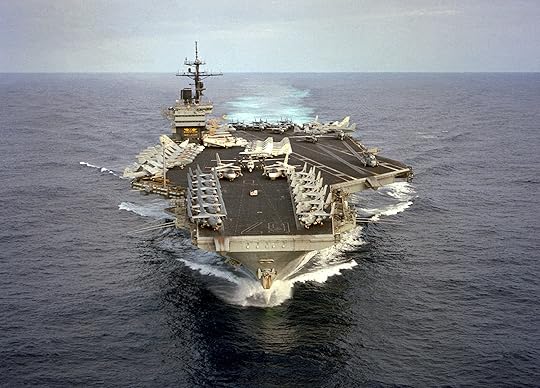 USS John F. Kennedy (CV-67) in 1991. Source: U.S. Navy
USS John F. Kennedy (CV-67) in 1991. Source: U.S. NavyGiven the size of the USS John F. Kennedy and the number of sailors onboard, the ship had several galleys. Jay was initially sent to work in the Air Wing galley where most of the enlisted members of his squadron ate, but it didn’t need people at that point, so he went to work in the ship’s main galley feeding the sailors assigned to the ship itself. Jay was fortunate to work for a Leading Petty Officer (LPO) and a Leading Chief Petty Officer (LCPO) who were both outstanding leaders. He credits them with setting him on the right path even though the work itself was not the most appealing. They wrote him excellent evaluations for the time he spent mess cranking and set him up for success with his squadron.
Jay and VF-32 returned to the United States onboard the USS John F. Kennedy in February 1987. Now an Airman (E-3), Jay was given the option to either work as a plane captain for another year at Oceana Naval Air Station or go directly to Integrated Weapons Team Work Center 280 to begin working on the equipment he had been trained to maintain and repair. Jay took the work center option, which allowed him to finally get back to doing what he really enjoyed and meet a great bunch of guys in the process. Although taking the option added two years to his enlistment, it allowed him to promote to Petty Officer Third Class (E-4) faster, making life in the Navy better all around.
Jay had one more deployment with VF-32 aboard the USS John F. Kennedy beginning in August 1990 in support of Operations Desert Shield and Desert Storm. Operating from the Eastern Mediterranean and the Red Sea, the aircraft carrier launched planes on combat missions against Iraq after it invaded Kuwait. The difference between this deployment and the previous one was that Jay was now a seasoned electronics technician, so his skills were essential in keeping VF-32’s Tomcats flying. He remembers spending many nights on the ship’s flight deck near the two F-14 fighters on “Alert 5”, meaning the planes were ready to be catapulted into the air on five-minutes notice. He and other maintenance people were on hand in case a last-minute problem developed that had to be fixed. Since there were lots of times when nothing went wrong, it gave the maintenance people the opportunity to talk and get to know one another. Jay recalls those conversations as some of the best discussions of his life.
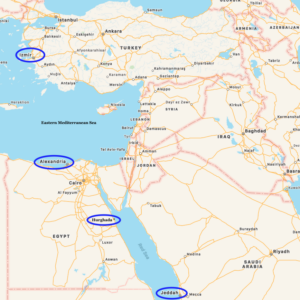 Jay’s port visits in the Eastern Mediterranean Sea and the Red Sea
Jay’s port visits in the Eastern Mediterranean Sea and the Red SeaAlthough the deployment was deadly serious, the ship made a few port calls and Jay got to visit some amazing places. He went ashore in Izmir, Turkey (where he visited ancient Greek and Roman ruins and met Kurds in person for the first time); Hurghada, Egypt; Alexandria, Egypt; and Jeddah, Saudi Arabia. In Jeddah, he was assigned to shore patrol duty on liberty buses transporting crewmembers around the port. He befriended the Saudi driver of one of the buses. The driver took him to a café where, according to local custom, Jay used his hands to eat rather than with western utensils. This opportunity to enjoy a meal with the Saudi bus driver stands out as one of Jay’s more memorable deployment experiences.
With the Desert Storm mission accomplished, Jay returned with VF-32 and the USS John F. Kennedy to the United States in March 1991, completing an almost nine-month deployment. Jay stayed with VF-32 at Oceana Naval Air Station until September 1992, when he decided to go back to being a civilian. After his discharge from active duty, he spent time touring Europe and even attended school in Spain, but ultimately returned to the United States and settled in Houston, Texas. While he was in Houston, he affiliated with the Naval Reserve and drilled with VFA-204, a Navy Reserve strike fighter squadron of F-18 “Hornets” flying out of Naval Air Station New Orleans. In 1994 he shifted to VFA-201, which flew out of Naval Air Station Dallas. Drills at both squadrons consisted of spending one weekend each month and two weeks each year working on F-18 Hornet radar systems, electronic countermeasure systems, communications systems, weapons systems, and other aircraft avionics. Although he especially enjoyed his time at VFA-201, by the summer of 1995 he needed a change and moved back to Chicago to live with his parents.
Moving back with his parents rekindled painful memories from Jay’s childhood and brought back stress and chaos to his life. He tried to stay affiliated with the Navy Reserve, drilling at Naval Air Station Glenview, but after just two monthly drill weekends, the installation closed as a result of the Base Realignment and Closure Commission (BRACC). He then shifted to drilling at the Great Lakes Naval Reserve Center, but that lasted for only a few months, as well. Not only did the Reserve Center have little for him to do, but when also coupled with the college studies Jay had begun at Harold Washington College and the unresolved family trauma he continued to deal with, it was just too much for him to handle. Although he took a break from drilling, he continued to work a variety of odd jobs to cover his school costs and rent, including helping his father with his catering truck and working security at Soldier Field.
Eventually, Jay decided to pursue his Bachelor’s degree. After applying to a number of schools, he enrolled at the University of Minnesota in Minneapolis-St. Paul. He saw this as an opportunity to both further his education and get out of his parents’ house. Once he arrived in the Twin Cities, he drilled with a Navy Reserve unit there, but they had nothing for him to do and he was bored. Not wanting to waste his time, he changed his status from a drilling reservist to the Individual Ready Reserve (IRR). This kept him on the Navy Reserve’s rolls in case he was needed, but he no longer needed to drill. When his IRR obligation expired in 1998, the Navy was officially in Jay’s past.
In looking back over this period of his life, Jay realizes he would have benefitted from counseling to help him address the nagging issues from his childhood. As a kid, he was often in the “flight” mode, trying to get away from the bad situation at home. Now that same instinct made it difficult for him to find direction and focus. The result was he struggled to find himself and couldn’t get across the finish line for either his Associate’s or his Bachelor’s degree.
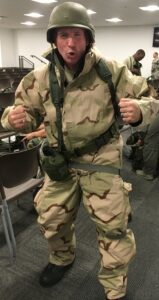 Jay Mastrud having some fun while training with the Wyoming Air National Guard
Jay Mastrud having some fun while training with the Wyoming Air National GuardThere was one aspect of Jay’s life that did provide structure and direction—his service in the military. Jay recognized that and again sought it out, this time enlisting as a Staff Sergeant (E-5) in the Minnesota Air National Guard in December 2000. The Air National Guard was a perfect fit for Jay given his prior Navy experience as an electronics technician, and it promised meaningful work he could do while attending classes at the University of Minnesota. He was initially assigned to the 133rd Maintenance Squadron of the 133rd Airlift Wing, where he worked on the avionics for the C-130 “Hercules” transport plane. Since he already had extensive training in the Navy, he asked for and was told he would get a waiver from the Air Force’s basic electronics training school, but his command never obtained the waiver. Accordingly, in July of 2001, he transferred to the Iowa Air National Guard.
Although Jay’s transfer to the Iowa Air National Guard was significant, the most important event of the summer was his marriage to his wife, Heidi. As they began their lives together, Jay also began drilling with the 133rd Test Squadron in Fort Dodge, Iowa. The assignment entailed Jay going to school at Keesler Air Force Base on the Gulf Coast of Mississippi to learn to work on ground radars. Then, on September 11th, the world changed with the terrorist attacks on the World Trade Center in New York City and the Pentagon in Arlington, Virginia.
After the attacks, Jay was activated to full-time active status and deployed stateside in response to the national emergency. Not only did this make for a rough start for his marriage to Heidi, but it interrupted his studies at the University of Minnesota. Once his active duty period ended in 2003, he returned to Minnesota to pick up where he left off. He also returned to the Minnesota Air National Guard in September 2003, this time as part of the 210th Engineering & Installation Squadron, drilling at the Minneapolis-St. Paul International Airport. This assignment was a good fit for Jay, and it complemented his new full-time civilian employment in 2007 with the Federal Aviation Administration (FAA). He even got to deploy with the unit to Alaska and was promoted to Technical Sergeant (E-6) in 2007. However, the assignment involved a lot of travel and was very tough on Jay’s family, which now included two young children who needed him at home. Although that would be sufficient reason in and of itself, Jay’s mother-in-law was battling cancer and her health was declining. Accordingly, in 2009, Jay decided it was time to hang up his boots and end his Air National Guard career.
By late 2009, lots of the pieces in Jay’s life were starting to fit together in a way that made Jay’s transition to a full-time civilian possible. He had a stable, good-paying job with the FAA. He’d finished his Associate’s degree in Liberal Arts from Harold Washington College in May of 2006, earned his Associate’s degree in Electronics Systems from the Community College of the Air Force in November of the same year, and earned his Bachelor’s degree in Classical Civilization from the University of Minnesota in May of 2008. He also had a wonderful family he loved very much. He still, however, had unresolved trauma from his childhood that kept him from experiencing the joy in life he knew he should be feeling.
Jay thought that perhaps connecting with other veterans through the American Legion or the Veterans of Foreign Wars (VFW) would help him come to terms with his past. For some reason, he convinced himself he didn’t fit in, even though the veterans he met were very welcoming. Then around 2010, he found Veterans in the Arts. The program offered veterans a way to find healing from trauma experienced in the military through a wide range of art projects, including writing, theater, glass blowing, and pottery. Jay took a chance and tried it. The results were life changing. The program introduced him to a number of veterans with different military experiences—some not as positive as his—and helped him see things through their eyes. Being accepting of their experiences also helped him deal with his own trauma, and for the first time, he sought professional counseling to help him come to terms with his past. He even co-founded the Warrior Writers Twin Cities writing group with two other veterans and had an article published in November of 2016, The Pacifist Preacher & Quanah Parker. At the same time, he became involved with the Veterans Play Project produced by Wonderlust Productions, which had several performances at historic Ft. Snelling in Minnesota. This experience further broke down barriers for Jay by exposing him to people with differing backgrounds and views, all bonding together through the arts.
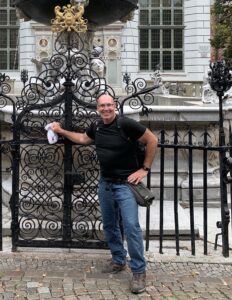 Jay Mastrud sightseeing in Gdansk, Poland
Jay Mastrud sightseeing in Gdansk, PolandOn the road to healing and with a better view of who he was in hand, Jay returned to the military in August 2012. He enlisted in the Air Force Reserves in Minneapolis, drilling with the 27th Aerial Port Squadron of the 934th Airlift Wing at Minneapolis-St. Paul International Airport, where he planned and organized air transportation activities. He did this until August 2014, and then transferred to the Wyoming Air National Guard in December of that year, where he drilled with the 243rd Air Traffic Control Squadron until May of 2019. In this assignment, he provided technical expertise in maintaining air traffic control equipment and deployed with the unit to maintain combat readiness.
In September of 2019, Jay transferred to the Wisconsin Air National Guard with the 128th Air Control Squadron, to drill closer to home. Jay is responsible for maintaining the unit’s transportable ground radar system and for training other unit members to do the same. He’s deployed to Poland augmenting an active duty unit from Italy and feels as though the assignment has really allowed him to blossom as a leader. In fact, in May of 2020, he promoted to Master Sergeant (E-7), validating his long commitment to military service and his years of searching for and finally finding his military identity. The assignment has also allowed him to connect with others in the command who Jay admires because they model what it is to be a true citizen-soldier.
Today, Jay and his family live in St. Paul, Minnesota. Having learned from his own experience the importance of positive relationships and personal accountability, he is a staunch advocate for seeking professional help to overcome trauma, PTSD, and any other of life’s hurdles. He sees doing so as a sign of strength and determination, and is living proof that it works. He urges others who may be struggling to seek out the help they need, and not suffer needlessly while trying to “fix things” on their own.
Voices to Veterans is proud to Salute Master Sergeant Jay C. Mastrud, U.S. Air Force, for his years of dedicated service in the Navy and the Air National Guard. Not only did he serve during a wartime deployment on board the USS John F. Kennedy during operation Desert Storm, but he has dedicated years of his life to the Air National Guard, keeping aircraft flying and radars protecting our skies. For his years of service, his personal sacrifices, and the leadership he continues to provide in both his military and civilian assignments, we wish him fair winds and following seas.
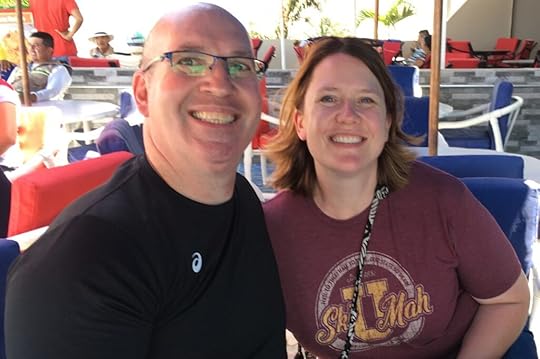 Jay and Heidi Mastrud
Jay and Heidi Mastrud
March 22, 2021
Sergeant Kenny L. Esmond, U.S. Army – Vietnam: Not Scared, Not There
There’s nothing like growing up in a small town. Close-knit families and neighborhoods, safety and security from the hustle and bustle of the city, and the freedom to roam and explore without fear. Sergeant Kenny L. Esmond grew up in such an environment, rarely venturing beyond his familiar Wisconsin surroundings. Yet even a trip to nearby big cities like Milwaukee or Chicago paled in comparison to what the U.S. Army had in store for him, shipping him off at just twenty-one to far off outposts in South Vietnam in the middle of a raging war. Although he returned to his small town after the war, his life was forever changed. This is his story.
Kenny was born in 1949 and grew up in Genoa City, Wisconsin, a small village just north of Wisconsin’s border with Illinois. At the time, the village had about 1,000 residents, so life there epitomized life in every small town in America. Kenny’s father, a World War II veteran, had a great job as a die caster for the Electric Autolight company in Woodstock, Illinois, making parts for cars like the famous hood ornament for the Ford Mustang. Kenny’s mother was a full-time stay-at-home mom, bearing the primary responsibility for raising Kenny and his younger sister. Kenny fondly remembers being allowed to play outside with all the other kids in the neighborhood, with his mother’s only instructions being to be home by 5:00 p.m. on school nights and by the time the streetlights came on in the summer. For a kid, it was small town living at its best.
High school was not as fun. Kenny did not enjoy his classwork at all—so much so that one day he walked out the door of Badger High School in Lake Geneva, Wisconsin, and decided not to go back. Once out the door, he wasn’t sure what he was going to do. He didn’t have a driver’s license or a car—all he knew was that anything had to be better than wasting his time in school. An opportunity arose when an older cousin told him that a factory in nearby Richmond, Illinois, was hiring. Kenny applied, stating on the application he was eighteen, despite being not quite seventeen at the time. Much to Kenny’s surprise, he got the job and started working as a die caster, just like his father.
Kenny was a hard worker, so he did well at the factory. After a little over a year, though, he started having regrets for having quit high school. Still without a driver’s license, Kenny enlisted a friend to take him to Badger High School and he made his way to the principal’s office. The principal was surprised to see Kenny and even more surprised when Kenny asked if he could come back to school to earn his diploma. The principal told Kenny it would take three years, or two years if he worked really hard. Kenny replied that he was already eighteen, so the two-year option was his only real choice. Kenny went on to graduate from Badger High School on June 6, 1969, exactly one month after his twentieth birthday.
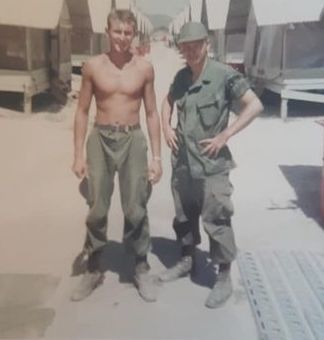 Kenny and another soldier in Vietnam
Kenny and another soldier in VietnamAt the end of 1969, the inevitable happened—Kenny was drafted. He reported to the Military Entrance Processing Station in Milwaukee, together with all of the other local draftees. He was given a physical exam, signed some paperwork, and was sworn-in on active duty. From there, he and the other draftees destined for the Army boarded a plane en route to Basic Training, or “boot camp”, at Fort Campbell, Kentucky. Although they arrived in early December, their formal Basic Training was not scheduled to begin until the full complement of draftees reported in January. In the interim, they trained informally for the two or three weeks preceding the holidays. They were even permitted to take leave and go home for Christmas. Once they returned, the Army’s intense eight-week Basic Training program began.
Kenny liked boot camp because of the way the Army transformed his group of undisciplined draftees from around the country into a cohesive platoon of soldiers. The reason behind the transformation was Drill Sergeant West. Built like a fireplug and a veteran of the war in Vietnam, he wasn’t someone to mess with. Kenny considered him tough but fair, and he inspired Kenny’s platoon to excel. One memory that stands out for Kenny was standing in the front row during weapons inspections. When Drill Sergeant West walked down the row, each trainee presented their weapon to the sergeant, who would inspect it and throw it back to the recruit. Kenny said Sergeant West always gave him a little signal, like a slight nod or wink before he threw the weapon back so Kenny would be prepared to catch it. As a direct result of Drill Sergeant West’s leadership and example, Kenny’s platoon was selected as the Honor Platoon for the Basic Training graduation parade.
After completing Basic Training, Kenny wanted to attend “Jump School” to become an Army paratrooper. He instead received orders to attend supply clerk and warehouse management school at Fort Polk, Louisiana—the same place his father had trained during World War II. Kenny completed his training in April 1970 and received orders to report for duty in the Republic of South Vietnam. His orders did not assign him to a specific unit. Because he was a replacement soldier, he would not learn his specific assignment until he arrived in Vietnam. So, without knowing what the future had in store for him, Kenny took eighteen days of leave at home in Genoa City before reporting to the Oakland Army Terminal in California to wait for a flight to take him off to war.
Once at the Oakland Army Terminal, now Private Kenny Esmond had to wait along with all of the other soldiers for their names to appear on a roster indicating they had been manifested on a particular flight. When Kenny and the other men on his flight heard their names called, they picked up their gear and marched to a big metal building where they were locked down until it was time to board. The building remained lit twenty-four hours a day so the men could be closely monitored in case anyone attempted to leave. Other than calling home on the building’s phones to say goodbye to loved ones, there was nothing to do but wait.
Once Kenny finally boarded his flight, he began the twenty-two hour trek to South Vietnam. The plane made several refueling stops along the way, including Hawaii, Wake Island, and Japan, before it finally arrived in Vietnam on May 12, 1970. Kenny was initially assigned to the Headquarters Company of the 101st Airborne Division and was transferred to Camp Evans for training. At Camp Evans, which was located sixteen miles northwest of Hue City—the scene of intense fighting during the 1968 Tet Offensive and a North Vietnamese massacre of thousands of South Vietnamese civilians—Kenny learned to conduct jungle patrols, do river crossings, and defend positions in this new, hostile environment.
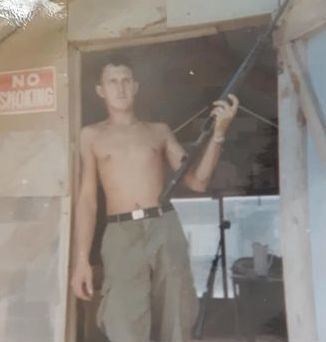 Kenny with his rifle in Vietnam
Kenny with his rifle in VietnamAfter almost two weeks of jungle school, Kenny reported to his permanent assignment at the U.S. base at Phu Bai, located eight miles southeast of Hue City on Highway 1, a coastal highway that ran the entire length of South Vietnam. Kenny was assigned to the 1st Battalion of the 502nd Infantry Regiment, 101st Airborne Division. When he reported to his sergeant, the sergeant asked Kenny what he knew how to do. Kenny told him his military occupational specialty, or “MOS”, was supply clerk and warehouse management. The sergeant said he wanted Kenny to work in the battalion ammo dump, but he didn’t need people there now. In the interim, he sent Kenny to Fire Base Bastogne—named after the famed defense of the City of Bastogne, France, by the 101st Airborne Division during the Battle of the Bulge—to serve as part of the defensive force protecting the artillery batteries operating there.
Fire Base Bastogne was located about twenty miles southwest of Hue City and was home to several artillery batteries firing 105-millimeter, 155-millimeter, and 8-inch shells. Kenny’s job was to man the base’s defensive bunkers and repair any damaged concertina wire strung around the base to protect it from enemy attacks. One reason for the frequent repairs to the concertina wire was the nightly “mad minutes”, when the base defenders opened up with all of their weapons, firing into the dark all around the base to interrupt the enemy in the event they were assembling for an attack or trying to infiltrate the base perimeter. While the mad minutes were effective in disrupting any would be North Vietnamese attackers, they also often damaged the concertina wire defenses, so Kenny and others had to check and make repairs to the wire every day.
After a brief stint at Fire Base Bastogne, Kenny returned to Phu Bai where he continued on bunker and repair duty. Defensive bunkers were built at intervals around the entire perimeter of the base. Each bunker was about eight feet square with sandbag walls and a plywood and sandbag roof. The bunkers had an opening in the front facing the perimeter and an opening in the back allowing entry and exit while shielded from enemy fire. During the day, the bunkers were manned by a single soldier. At night, four soldiers stood guard at each bunker, two outside in fighting positions while the other two slept inside in two-hour shifts. Kenny had nighttime guard duty every other night, while during the day he worked his other military responsibilities.
 Hue City and Phu Bai in South Vietnam, Source: U.S. Government
Hue City and Phu Bai in South Vietnam, Source: U.S. GovernmentOn Kenny’s first night of guard duty at a bunker on the perimeter of Phu Bai, he was manning an M60 machine gun in a fighting position out in front of the bunker when he heard a sound he recognized from his training at Camp Evans. It was the sound of rocket-propelled grenades (“RPGs”) being launched from somewhere out in the darkness. It was common knowledge that the Viet Cong (“VC”) in the area knew the layout of the base’s perimeter defenses, so Kenny was sure they knew where he was. The first RPG hit behind the line of bunkers about one hundred yards to Kenny’s left. Sparks flew thirty-five to forty feet into the pitch black night. A second RPG passed directly over Kenny’s head, again landing behind the bunkers. The enemy continued to launch RPGs, walking them down the line of bunkers, each manned by young defenders like Kenny. Knowing what the results of a direct hit by an RPG would mean, Kenny was terrified. He describes his fear in simple terms: “If you weren’t scared, you weren’t there.”
On another evening when he was standing bunker guard duty, he heard small arms fire opening up further down the bunker line. The word came over the radio that the VC were probing the perimeter and that each bunker team needed to send one man to the area to assist in repulsing the attack. Kenny drew the short straw and started running down the line of bunkers toward the engagement. He was not completely out in the open in that outside the line of bunkers and firing positions, a dirt berm had been constructed to provide cover for those occupying the defensive perimeter. Still, as Kenny ran toward the sound of the gunfire, he remembers praying—not that he would live—but that Jesus would accept his soul. By the time Kenny arrived, the gunfire had subsided and the attack had been repulsed, but it had been a harrowing few minutes. To this day, whenever Kenny hears fireworks on the Fourth of July, it takes him back to Phu Bai, running along the base perimeter alone at night, not knowing what was waiting for him or if he would survive.
The North Vietnamese and the VC weren’t the only ones attacking the bunkers. One night when Kenny and three other soldiers were standing guard in a bunker on the perimeter of Fire Base Bastogne, a King Cobra slithered into the bunker while the men were inside. Kenny described the ensuing melee like a scene from the Three Stooges as they all scrambled to get out of the bunker. When everyone was clear, one of the soldiers killed the invader with his M16, prompting a radio call from the officer-of-the-day asking what was going on. When they told him about the King Cobra, the officer-of-the-day told them they should have killed it with a stick. That was one piece of advice they had no intention of following.
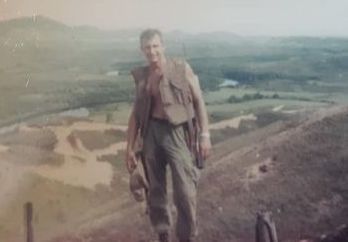 Kenny with the South Vietnamese countryside behind him.
Kenny with the South Vietnamese countryside behind him.Because Kenny was a supply clerk, his daytime duties at Phu Bai initially involved managing the supply records for the uniform inventory in support of the Property Book Officer. After two months, though, he was so bored that he went to the Property Book Officer and said he needed to do something else. Appreciating the initiative, the Property Book Officer sent Kenny across the street to the battalion ammunition (“ammo”) dump to talk to the sergeant in charge. When the sergeant heard Kenny wanted to work in the ammo dump, which supplied small arms ammunition to infantry companies in and around Phu Bai, the sergeant just shook his head and told Kenny to come in and get started.
Kenny’s duties working at the ammo dump were wide and varied. When the inventory of M-16 and 40-caliber ammunition and cratering charges grew low, he would requisition more and ride in a two-and-a-half ton (“deuce and a half”) truck to the main ammo dump on the other side of Phu Bai to pick it up. These trips were dangerous enough because Kenny was riding in a truck filled with ammunition, but on at least one occasion he was fired upon as he passed through a hamlet on this way to pick up the load.
As time passed and Kenny became familiar with all of the ammo dump’s procedures, both of the sergeants who were senior to him “went back to the world”, which meant they returned to the United States. This provided an opportunity for Kenny because he was promoted to sergeant and took over the ammo dump after the two sergeants left.
Once Kenny was in charge, one of his new responsibilities was to travel to the surrounding fire bases to restock their ammunition inventory. To tackle this mission, Kenny heloed out to the fire base, inventoried the ammunition on hand, and radioed back an order to bring the fire base’s ammunition back up to its base load. The next day, a helicopter would fly in with the ammunition. Kenny and other soldiers would unload the ammunition onto an open flatbed vehicle known as a “mule” and drive it to the fire base bunkers to restock their supplies. Kenny would then hitch a ride back to Phu Bai on a logistics helicopter later in the day. Similarly, if units were heading home to the United States as part of the U.S. troop drawdown, Kenny would visit the unit, collect its ammunition, and return it to the battalion ammo dump.
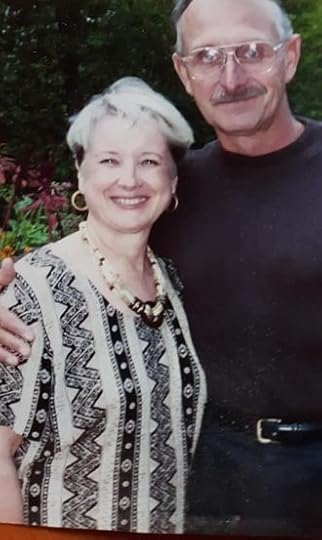 Kenny and his wife, Kathy
Kenny and his wife, KathyAs Kenny neared the end of this one-year tour in Vietnam, he decided to extend in country for two more months to figure out his future. On one hand, he was now a sergeant and had done very well, even having been awarded an Army Commendation Medal for his outstanding work and dedication to duty. That made a career in the Army a real option. On the other hand, he wanted to get home to his family and didn’t want a follow-on assignment in Germany, which was a real possibility. In the end, his family and Genoa City won out. Kenny departed South Vietnam on July 6, 1971. Upon his return to the states, he was honorably discharged at Fort Lewis, Washington. He then went back to Genoa City to pick up life where he had left off.
Once he got back, though, he felt like nobody cared what he had done. Even more hurtful, he felt like people avoided him because he had served in Vietnam. Although he was immensely proud of his wartime service, it wasn’t until a fellow Vietnam veteran shook his hand and told him “Welcome home, brother,” at a Memorial Day ceremony forty years later that he started to feel like he belonged again. At the ceremony, Kenny participated in a talking circle, where every veteran attending was given the microphone and an opportunity to talk. After Kenny spoke, the other veterans hugged him, letting him know his service was valued. The event finally let Kenny reconcile how his service in Vietnam had influenced his life.
Kenny is retired now, having worked in construction ever since his return from Vietnam. He is happily married to Kathy, his wife of thirty years, and living in Genoa City. He’s once again enjoying the benefits of living in small town America, just as he did as a kid.
In addition to the Army Commendation Medal, Kenny was awarded the Combat Infantryman Badge and the Bronze Star for his outstanding service in Vietnam. He also wanted to be sure the following special message was included in his story: “To all my sisters and brothers who served in the military—Ooorah!”
Voices to Veterans is proud to salute Sergeant Kenny L. Esmond, U.S. Army, for his willingness to serve our country during time of war. At just twenty-one years old, he put his life on the line in far off South Vietnam because he believed in our nation and our democracy. We thank him for his dedication to duty and committed service, and wish him fair winds and following seas.
February 10, 2021
Senior Airman Robert Johnson, U.S. Air Force – Duty Above the Arctic Circle
When you enlist in the military, you never know what Uncle Sam has in store for you. In essence, you are giving the military a blank check to write your future for the term of your enlistment and often beyond. Such was the case for Senior Airman Robert Johnson, who joined the Air Force in 1966. Little did he know that a few months later, he would be stationed at the United States’ northernmost military base, just 950 miles from the North Pole. This is Bob’s story.
Bob was raised in upstate New York in the small town of Oakfield, located about forty miles east of Buffalo. His father drove a tanker truck delivering heating oil to homes – a booming business given the harsh Buffalo winters and the heavy snowfalls blowing in from Lake Erie. His father worked his way up from driving a truck to operating several trucks of his own, while Bob’s mother worked at Sylvania in addition to taking care of Bob and his older brother and younger sister. Bob’s father taught Bob and his older brother to love the outdoors and they were avid hunters. Bob got his first shotgun when he was fourteen and one of his fondest memories of growing up was when his father would come home from work and take Bob and his brother hunting in the nearby woods.
Bob spent all of his school years in Oakfield and was active in sports. He took up weight-lifting in high school, ran cross-country, and joined the rifle team. He graduated in the spring of 1963 and enrolled in the University of Louisville in Kentucky in the fall. At the end of three years, though, he’d had enough, realizing college just wasn’t working for him, so he returned home and told his parents he wasn’t going back to school.
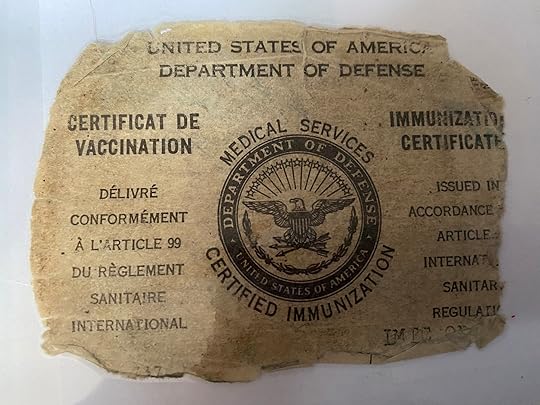 Bob’s original Air Force immunization card
Bob’s original Air Force immunization cardBy now it was the middle of 1966 and President Lyndon B. Johnson was escalating U.S. participation in the Vietnam War. Rather than wait for the draft where his options would be limited, Bob enlisted in the Air Force. After saying goodbye to his parents, he boarded a plane for the first time in his life and flew to San Antonio, Texas, for basic training at Lackland Air Force Base. After eight weeks of basic training, then-Airman Johnson boarded another airplane, this time headed to his technical school at Keesler Air Force Base near Biloxi, Mississippi.
At Keesler, Bob trained to become a radio communicator, which he enjoyed. He spent much of his time in class learning what to do and what not to do while talking on the radio and practiced communications procedures through mock radio transmissions. He also enjoyed being assigned so near the Gulf Coast, with miles of sandy beaches just a short drive away. He spent time at the beach whenever his liberty schedule allowed, as well as in the city of Biloxi. His time in the sun-drenched Gulf of Mexico was short-lived, because near the time of graduation he learned that his first assignment would be at Thule Air Base, doing “radio communications at the top of the world.”
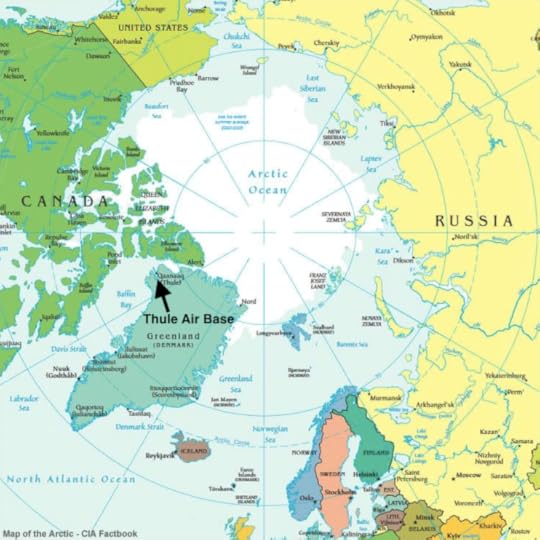 After graduation in 1967, Bob started on the long flight to Thule. His plane stopped in Canada to refuel and then continued to the U.S. air base located 750 miles above the Arctic Circle on the Danish island of Greenland. The strategically located base, just hours from the Soviet Union’s arctic coast, played a significant air defense role during the Cold War, at times hosting strategic bombers poised to attack the Soviet Union and fighter-interceptors whose mission was to prevent Soviet bombers from reaching the United States and Canada. Just as important, the base’s sophisticated radars were intended to provide the United States and its NATO allies an early warning if the Soviet Union were to launch intercontinental ballistic missiles armed with nuclear warheads towards the western alliance. Not that there was anything that could be done to stop the missiles once inbound, but Thule’s early warning was essential in making sure the Soviets knew there would be a response in kind.
After graduation in 1967, Bob started on the long flight to Thule. His plane stopped in Canada to refuel and then continued to the U.S. air base located 750 miles above the Arctic Circle on the Danish island of Greenland. The strategically located base, just hours from the Soviet Union’s arctic coast, played a significant air defense role during the Cold War, at times hosting strategic bombers poised to attack the Soviet Union and fighter-interceptors whose mission was to prevent Soviet bombers from reaching the United States and Canada. Just as important, the base’s sophisticated radars were intended to provide the United States and its NATO allies an early warning if the Soviet Union were to launch intercontinental ballistic missiles armed with nuclear warheads towards the western alliance. Not that there was anything that could be done to stop the missiles once inbound, but Thule’s early warning was essential in making sure the Soviets knew there would be a response in kind.
It was in this Cold War setting that Bob found himself. He was welcomed by members of his unit as soon as he disembarked the plane, and they began immediately briefing him on what he needed to do to survive in the harsh arctic environment. They issued him cold weather clothing and warned him that during the winter it would be nothing for the temperature to drop to -40 degrees Fahrenheit, with the average winter temperature hovering at a frigid -20 degrees. On top of that, when storms would blow through, wind speeds could exceed 100 miles per hour, making the wind chill unbearable. As if that wasn’t enough, as far north of the Arctic Circle as they were, it remained dark 24 hours a day from November through February. Bob understood quickly that not taking the warnings seriously could prove deadly.
As a radio operator at Thule, Bob communicated with inbound and outbound military aircraft. He passed weather information to the aircrews and let them know what the landing conditions were. He also found a way to “patch” the radio broadcast of the 1967 World Series between the St. Louis Cardinals and the Boston Red Sox through to the U.S. planes flying for hours on end above the Arctic. One plane’s aircrew even called in and asked Bob to send them the World Series, too, once they heard it was something he could do. Unfortunately, Bob’s superiors didn’t like the idea and they shut down Bob’s baseball broadcasts once they became aware of them.
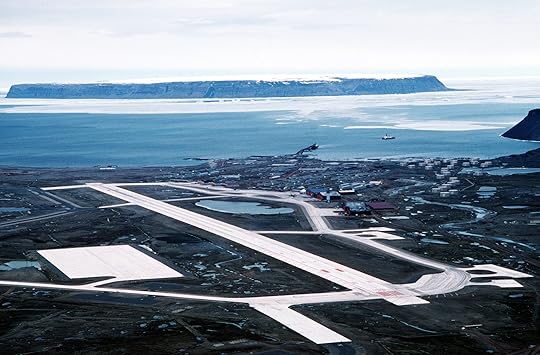 An aerial view of Thule Air Base.
An aerial view of Thule Air Base.Although the landscape surrounding Thule was desolate, Bob found it strangely beautiful. In fact, he describes his time there as one of those rare, wonderful experiences when you get to meet Mother Nature. During the summer months when the temperature would rise to about 40 degrees Fahrenheit and it would be light 24 hours a day, Bob and his friends would explore the area around the base on hiking trails, or just sit outside with a good book and enjoy the sun. Sometimes they would even see a ship pull into the harbor to drop off supplies, although much of what they needed came in by air.
Year round, when they weren’t on duty, they worked out at the barracks gym or visited their friends and talked in their rooms. Bob kept snacks and non-alcoholic drinks in his room all the time, so it was common for friends to stop by and chat. In the evening, they could go to the enlisted club for a meal or some entertainment and a drink or two, before hunkering down in their barracks for the night. Not even their barracks were safe enough when big storms hit the base and they had to evacuate to more secure buildings designed to withstand the strong winds and bone-chilling cold.
On one occasion when a severe storm set in, everyone was restricted to quarters and the barracks staff began taking a roll call. Bob was missing. They began to search the barracks and were getting ready to call for a search outside when they found him visiting with African American Airmen he had become friends with. Amid the racial tensions of the 1960’s, this demonstrated in a simple way Bob and his friends’ commitment to treat each other with dignity and respect and to help break down societal barriers. Of all of the Air Force stories Bob has told his children and grandchildren over the years, this one had the greatest impact because of the life lesson it taught. In fact, Bob’s children and grandchildren felt so strongly about it that they specifically asked him to include it as part of his Air Force story.
Although Bob loved his assignment at Thule, when he got the chance to take leave, he went to the opposite weather extreme. Taking advantage of discount air fares available to military members and the money he’d saved in Greenland, he visited both Hawaii and Florida in an effort to thaw out from his deep freeze in the arctic. These vacations also helped break his assignment into more tolerable segments.
Bob’s tour at Thule lasted one year, meaning he still owed the Air Force another eighteen months after leaving Thule. He was assigned to follow-on duty at Chanute Air Force Base in east-central Illinois. There he spent the rest of his enlistment typing base communications and performing other administrative functions for the Chanute military community.
After completing his three-year commitment to the Air Force, Bob was honorably discharged as a Senior Airman in 1969. His first order of business was to find a job, which he did in the nearby community of Champaign, Illinois, working for Kraft Foods. He also met the love of his life, Linda, and they were married in 1978, bought a home, and raised four children. Bob stayed at Kraft until he retired in 2000, having worked his way up from an entry-level position to an Assistant Supervisor, but his work career was not quite over just yet.
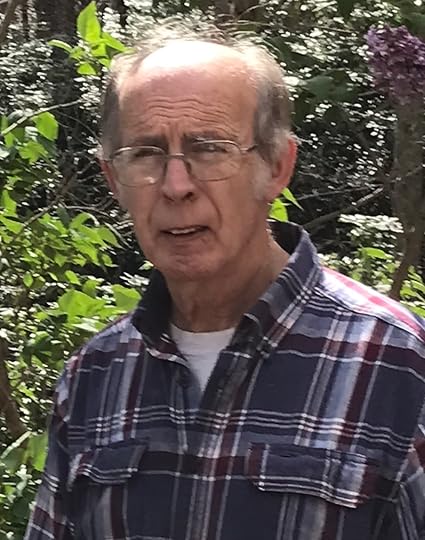 It turns out that Linda loved to ski and she got Bob hooked. So much so that Bob took a leadership role in the local ski club, which chartered buses to go on ski trips to Northern Michigan, West Virginia, and the Rocky Mountains. On one such trip to Snowshoe Mountain after Bob retired from Kraft, Bob was hired to take charge of Guest Services, so he and Linda moved to West Virginia.
It turns out that Linda loved to ski and she got Bob hooked. So much so that Bob took a leadership role in the local ski club, which chartered buses to go on ski trips to Northern Michigan, West Virginia, and the Rocky Mountains. On one such trip to Snowshoe Mountain after Bob retired from Kraft, Bob was hired to take charge of Guest Services, so he and Linda moved to West Virginia.
Bob and Linda are now fully retired and living in North Carolina, where they are closer to their seven grandchildren and four great grandchildren. As Bob looks back over his time in the Air Force, he is proud of his service and believes it gave him opportunities and training he never would have had without serving. His experience also gave him the confidence to succeed in his follow-on jobs, as well as to work in a technical field.
Voices to Veterans salutes Bob for his service and his willingness to go to the ends of the earth to defend our freedom during the height of the Cold War. He saw his assignment to the isolated American air base not only as his duty, but also as an opportunity he had to be thankful for. We, too, are thankful for Bob’s service, and wish him fair winds and following seas.
January 20, 2021
Master Chief Legalman David S. Leafer, U.S. Navy (Retired) – The Recruiting Posters Were Right
Everyone has heard the old Navy recruiting slogan “Join the Navy – See the world.” It takes a special person, though, to follow through and visit a recruiter’s office, sign an enlistment contract, and put the slogan to the test. Master Chief Legalman David S. Leafer, U.S. Navy (Retired), did just that and found the Navy to be true to its word. Although it meant working long days at sea for months on end, a wartime deployment to the Red Sea onboard an aircraft carrier launching strikes deep into Iraq, and countless hours working on legal issues for the fleet, the opportunities Dave’s Navy career brought him exceeded his wildest dreams. He even got to meet the President and First Lady because he’d proven himself to be a bold and effective leader. This is his story.
Dave was born in 1961 and raised in Peabody, Massachusetts, a small town located twelve miles north of Boston. His dad was an electrical engineer and Korean War veteran, having served in the Air Force as a radar operator. His mom was an accountant for various businesses in the Boston area. Dave and his younger sister, Jodi, went through all levels of the Peabody school system, with Dave graduating from Peabody Veterans Memorial High School in May 1979.
Although Dave was a good athlete, at 135 pounds, he found greater success working after school rather than playing a sport but rarely getting into a game. A job he particularly enjoyed was working as a “lot boy” for a local Dodge dealership. On nights when it might snow, the dealership let him take a truck home from work even though he was a relatively new driver. The next morning, he would get up at 4:00 a.m., drive the truck to the dealership and plow the lot before heading off to school. He also worked at Kmart and between the two jobs, made pretty good money. So good, in fact, that after he graduated from high school, he continued to work for a year at the dealership, hauling in $12/hour, which wasn’t bad for an eighteen-year-old kid in those days.
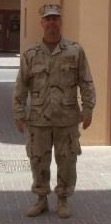 Master Chief Leafer in Bahrain
Master Chief Leafer in BahrainBy December 1980, Dave was bored. He had some friends who’d joined the military and wrote him from Hawaii and Japan, so he decided he needed to travel, too. He and a friend visited the local Armed Forces Recruiting Center, which had recruiters from all four services. He knew he didn’t want to be a Marine, but was otherwise open to the other services. His dad had been Air Force, but the Air Force recruiter was out for lunch, taking them off the table. Next up was the Navy recruiter, who gave Dave his full spiel. Dave was so impressed, he came back the next day and enlisted in the Navy.
The program Dave enlisted in was called the Delayed Entry Program. That meant he had to report to the Armed Forces Examining & Entrance Station, or AFEES, to begin his enlistment in February 1981. However, his report date was further delayed until June 8, 1981. When he and others with the same report date arrived, everyone was very nice to them. They were asked if they still wanted to enlist in the Navy and, after they said they did, they were sworn in as official U.S. Navy recruits. Dave then had one last opportunity to say goodbye to his parents, his grandparents, and his girlfriend, who had all come to see him off. Dave and the other Navy recruits were then transported to Boston’s Logan International Airport for the two-hour flight to Chicago and Basic Training at Naval Station Great Lakes.
The recruits arrived in Chicago around midnight and that’s when everyone stopped being nice. The Navy sailors that met the new recruits at the airport started yelling at them and never stopped. Dave, who hadn’t been yelled at before by anyone other than his parents, thought “what have I gotten myself into?”
Once at Great Lakes, each recruit was issued a blanket and told to get some sleep on the bunk beds in their assigned berthing areas. The next morning began bright and early and the yelling continued. Dave wanted to tell them to “go to hell”, but wisely held back. Others who failed to show the same restraint were separated from the group and not seen again.
The Chief Petty Officer responsible for Dave’s company of recruits was a Gunner’s Mate from the fleet who was “mean as hell.” He had a beard and Dave and the other recruits were afraid of him, but he taught them a lot about how to survive and succeed in the Navy. Years later, Dave ran across the Chief and learned he wasn’t mean at all—it was the role he played for the new recruits. Life on a ship could be unforgiving, so the new recruits had to learn to respect authority, follow orders, and function as a team. In that regard, Dave believed the Chief prepared him well.
Dave liked boot camp, except for peeling potatoes and scrubbing pots and pans. His duties and daily routine taught him discipline. Even the little things like folding clothes in the required way or making his bed gained him unexpected confidence in his abilities. He loved learning about Navy history and memorizing the plethora of acronyms the Navy uses. He also enjoyed the challenges and was appointed as an Assistant Recruit Chief Petty Officer (ARPOC), one of the Recruit Division Commander’s (RDC) primary recruit assistants, responsible for maintaining the division in good order. When the RDC assigned him an errand like getting the mail or running to pick up documents or other miscellaneous items, Dave seized the opportunity and used it to occasionally grab a cup of coffee, escape his recruit duties, and be stress free for a while.
Dave graduated from boot camp as a Seaman Recruit (E-1) in September 1981 with orders to report to the USS Sierra (AD 18), a World War II era destroyer tender commissioned in March 1944 and homeported in Charleston, South Carolina. The Sierra was essentially a floating machine shop that deployed with Navy battle groups and provided repair services for the battle group ships so they could continue their missions instead of having to return to shipyards to allow the work to be done. On one occasion, after assisting engine room personnel fix the periscope of the nuclear powered submarine USS Jacksonville, which was operating in the vicinity of Diego Garcia in the Indian Ocean, the submarine’s skipper allowed some of the working party to get underway with the sub to make sure the sub’s systems were in order. Dave was excited and all was going well until he learned the submarine was submerged. For some reason he does not understand even now, Dave did not move from the area where he was sitting for what seemed like an eternity. Although he had offers to do so again during his career, he never took another ride on a submarine.
During a leave period in 1983 while Dave was assigned to Sierra, he drove home to visit his parents in Peabody. As he was talking to his parents and his girlfriend at his parent’s house just prior to heading back to Charleston, he heard screams outside and saw smoke. He ran through snow covered back yards to his neighbor’s house and saw a car engulfed in flames with a man still inside. Without thinking about what he was doing, he ran to the car, pulled the man out, and dragged him to safety. The flames were so hot, the man’s glasses were melted to his head and ears. Just after Dave got the man to safety, the car was engulfed by fire and exploded.
Dave’s hands were burned and he went into what he can only describe as shock. When the police and the fire department arrived, he saw someone point to him and say, “he’s the one who saved the man’s life.” After that, Dave only remembers walking back to his parent’s house while his parents were outside watching what was going on and, without saying goodbye, jumping into his car to drive back to Charleston. He stopped at a Sunoco station to get some wiper fluid and gas and suddenly found himself surrounded by State Troopers. He was taken to Bethesda Naval Hospital just outside Washington, DC, where he was admitted and treated for burns on his hands, smoke inhalation, and fragments in his eyes from when the car exploded. He was subsequently awarded the Navy Commendation medal for saving the man’s life.
Dave returned to work and deployed with USS Sierra to the Indian Ocean. He also made other shorter deployments, allowing him to tour some amazing countries in the Mediterranean. Travel like this was what he had signed up for. He detached from USS Sierra in June 1984 and reported to Cruiser-Destroyer Group TWO, a multi-ship battle group commanded by an admiral whose flagship was the aircraft carrier USS Independence (CV 62). Dave enjoyed his time on the aircraft carrier so much that he really wanted to stay in the Navy. The assignment also led to a decision that changed the direction of his Navy career.
Dave reported to his next assignment at Naval Station Newport, Rhode Island, in June 1985. Newport was an ideal location because it was close to his parents and friends in case the Navy did not work out. While at Naval Station Newport, Dave was selected for promotion to Third Class Petty Officer (E-4). He was also sent to the Naval Justice School, located on the Naval Station, to assist with a legal investigation. At the school, where Navy attorneys known as Judge Advocates or “JAGs” and Navy paralegals, known as Legalmen, trained, Dave was introduced to the Navy’s legal system. He was immediately drawn to the Legalman’s responsibilities, working military justice issues and investigations and assisting JAGs handle courts-martial and a myriad of other legal responsibilities. He completed a conversion package to apply to become a Legalman and was selected to attend the Naval Justice School in 1987. He graduated from the Legalman course in December 1987 and was promoted to Legalman Second Class (E-5).
Dave’s first assignment as a new Legalman was at the prestigious Naval War College, which was also located in Newport. There he worked in an office with two senior people – a JAG Captain (equivalent to an Army Colonel) and a civilian professor of international law – supporting their efforts as instructors of courses for senior U.S. and international Navy and Marine Corps officers. Because the military justice workload at the War College was low, Dave seized on the opportunity to observe war games and listen in on strategy discussions. The insight he gained into Navy operations served him well throughout the rest of his Navy career.
While at the Naval War College, Dave passed the exam for promotion to Petty Officer First Class (E-6) and was “frocked”, which meant he was allowed to wear his new rank but would not receive the increased pay until it came his time to officially promote. The frocking ceremony was a big deal – hundreds of people came, including his parents. And now that he wore the uniform of a Petty Officer First Class, he was entitled to the rank’s privileges, including going to the head of the line at the galley for chow and at medical for sick call. He was also assigned a reserved front row parking spot. Needless to say, promotion to First Class is a significant milestone in a Sailor’s career.
Seven months later, the Admiral commanding the War College summoned Dave to his office. The Admiral told Dave the Bureau of Naval Personnel had made a mistake and that through no fault of Dave’s, he had not been eligible to take the First Class Petty Officer exam and therefore the Bureau was taking away his eligibility for promotion. In practical terms, that meant Dave had to remove his First Class Petty Officer stripe and revert to a Petty Officer Second Class. Moreover, he would have to take the exam again, even though he had passed it before. The Admiral weighed in personally with the Bureau to prevent it from happening, but the Bureau was adamant – Dave had to revert to Second Class.
The situation angered Dave, but he was humbled by how the Admiral went to bat for him. He also got good advice from a Senior Chief Legalman (E-8) who told him he’d been through a similar situation. He told Dave the best way to deal with it was to buckle down and show everyone he deserved to be a First Class. Dave did just that. He worked hard, took the next exam and passed it, and officially promoted to Petty Officer First Class at his next duty station in March 1991.
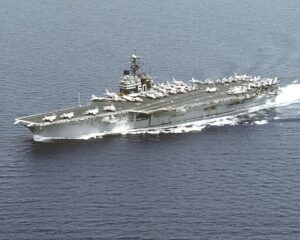 USS Saratoga (Source: U.S. Navy)
USS Saratoga (Source: U.S. Navy)Dave detached from the Naval War College in March 1990 and reported in April to the legal office onboard the aircraft carrier USS Saratoga (CV 60), which was homeported in Mayport, Florida. Just four months later, he was underway with the ship on a wartime deployment to the Red Sea in support of Operation Desert Storm after Iraq invaded Kuwait. The ship’s squadrons delivered tons of ordnance to targets in Iraq and Kuwait but lost three aircraft in the process. Before participating in Desert Storm, the ship also lost 21 enlisted sailors just three days before Christmas when a liberty boat returning crewmembers to the ship capsized in rough seas in the port of Haifa, Israel. Dave still commemorates the loss of his shipmates every year on the anniversary of the accident.
One high point of Dave’s tour on Saratoga was talking to then-Captain Joseph S. Mobley, the captain of the ship. Because Dave put together the disciplinary cases to be adjudicated by Captain Mobley, he got the chance to interact with him regularly on the bridge, something most enlisted sailors on board would never get to do. What made this particularly interesting was Captain Mobley had flown combat missions as a bombardier-navigator on A6A Intruders during the Vietnam War, was shot down in 1968, and was held as a prisoner of war until his release on March 14, 1973. Anytime Dave felt like he was having a bad day, he thought of what Captain Mobley had gone through at the hands of the North Vietnamese and suddenly his troubles didn’t seem so bad after all. One other high point of the tour was Dave earned his Enlisted Aviation Warfare pin, which meant he had demonstrated sufficient knowledge and skills with naval aviation operations to wear the insignia. Earning a warfare pin was essential to Dave’s career and continued advancement.
After returning to Saratoga’s homeport in Mayport, Dave transferred to the Navy Legal Service Office in Mayport in August 1992. There he assisted JAGs prosecute and defend courts-martial and helped provide legal assistance to Sailors assigned to the many ships and helicopter squadrons calling Mayport home. Just seven months later, he was selected to report to the Admiral commanding the multi-ship USS George Washington (CVN 73) Battle Group. Dave was a member of the Admiral’s staff and worked directly for the Battle Group JAG, who was the attorney responsible for advising the Admiral on international law, the law relating to naval operations, the rules of engagement for the use of military force, and military justice issues. The JAGs Dave worked for, then-Lieutenant Commander Gregg Cervi and Lieutenant Commander George Reilly, treated Dave as a teammate and gave him work to do that had historically been reserved for JAGs. Dave loved the work and excelled. He was able to assist and observe the JAGs briefing the Battle Group on the rules of engagement, as well as provide direct support on investigations and special events.
The most memorable event occurred during the Battle Group’s deployment in 1994, when the USS George Washington participated in the 50th anniversary commemoration of the D-Day landing at Normandy. Numerous dignitaries visited the ship, including President Bill Clinton and First Lady Hillary Clinton, the Vice President, and the Secretary of Defense. One late afternoon when the President was on board, a Marine came down the passageway telling everyone to clear the way for the President’s party. Dave and a group of other sailors were in their office and stood with the door open to watch the President walk by. As the party approached, Dave got up his nerve and asked White House Press Secretary Dee Dee Myers if they could get a picture with the President. Ms. Myers said no because they were on their way to dinner, but First Lady Hillary Clinton heard Dave’s request and said it was a great idea. The result was everyone in the office had their picture taken with the President and First Lady.
After the dignitaries left, the Admiral held an award ceremony recognizing all of the work everyone had done in helping coordinate the visits by the many dignitaries. He was all smiles until he called out Dave’s name. Dave, recalling the last time an Admiral looked somber and gave him bad news, feared he was about to be chewed out for asking the President’s party for pictures. Instead, the Admiral praised him for all he had done and said his action to get his shipmates a picture with the President and Mrs. Clinton epitomized what it means to be a Navy leader.
Dave’s efforts coordinating with the Secret Service and the White House Communications staff earned him the trust of the Admiral and the Battle Group JAG, and a plum temporary assignment in New York City after the Battle Group returned to Norfolk in November 1994. Each year in the spring, New York City opens its doors to the Navy during Fleet Week, when ships and Sailors visit the City to promote the Navy and its mission. In early 1995, Dave was sent to New York City as the Officer-in-Charge of an advanced party, arranging things like transportation and catering and planning for a wide range of events. He worked closely with the Mayor’s personal assistant during his entire time in New York. During one such event, Dave was wearing his summer white uniform sitting on a couch at the Mayor’s mansion talking to people when actor Kevin Kline dropped a Swedish meatball that landed on Dave’s uniform. The Mayor’s personal assistant quickly ushered Dave into a bedroom and told him to take off his uniform so it could be cleaned. While Dave was sitting on the bed in his skivvies waiting for his uniform, the Mayor and his wife walked in and wanted to know what was going on. Dave and the Mayor’s personal assistant explained the situation and a few minutes later, his uniform re-appeared, cleaned and pressed and inspection ready. Then it was back to the event as if the incident had never happened.
In addition to earning his Enlisted Surface Warfare pin while on board George Washington, Dave earned many accolades for his Battle Group tour, including Battle Group Sailor of the Year and the Navy Judge Advocate (the three-star JAG Admiral responsible for the Navy JAG Corps and all Legalmen) Sailor of the Quarter. But by January 1996, it was time to move on to Dave’s next assignment at the Trial Service Office in Mayport, Florida, where he helped Navy JAGs prosecute courts-martial and assisted Navy commands with their military justice needs. During this tour, Dave was selected for Chief Petty Officer (E-7), the most prestigious promotion for an enlisted sailor during the course of a Navy career.
At the Trial Service Office, Dave learned about leadership and taking care of sailors firsthand, and was selected as a Command Chief. He also attended a Heisman Trophy event at the Sawgrass Country Club in nearby Ponte Vedra Beach, Florida, where he received a football autographed by numerous Heisman Trophy winners. While there, he met and spoke with legendary Yankees player and coach Yogi Berra, who added his autograph to the football despite learning Dave was a die-hard Red Sox fan.
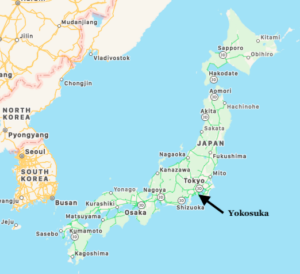 Dave transferred to the legal office at Naval Air Station Jacksonville in September 2000. He was selected for promotion to Senior Chief Petty Officer (E-8), the second highest enlisted rank in the Navy, in September 2002. He then transferred to the Region Legal Service Office, Yokosuka, located on a U.S. Navy base about thirty miles south of Tokyo. The Region Legal Service Office prosecuted courts-martial and advised the forward deployed ships and squadrons of the U.S. Seventh Fleet on a broad range of legal matters. In addition to supporting those efforts and assisting his Commanding Officer, and as the senior Legalman in the Western Pacific, Dave traveled to wherever Legalmen were assigned – Guam, Hawaii, Thailand, the Philippines, and other bases in Japan – to ensure they had the support they needed to serve the legal needs of their commands. Dave’s area of responsibility included 45 regional Legalmen. During the visits, he listened to his sailors’ issues, helped address their requirements, and mentored them professionally.
Dave transferred to the legal office at Naval Air Station Jacksonville in September 2000. He was selected for promotion to Senior Chief Petty Officer (E-8), the second highest enlisted rank in the Navy, in September 2002. He then transferred to the Region Legal Service Office, Yokosuka, located on a U.S. Navy base about thirty miles south of Tokyo. The Region Legal Service Office prosecuted courts-martial and advised the forward deployed ships and squadrons of the U.S. Seventh Fleet on a broad range of legal matters. In addition to supporting those efforts and assisting his Commanding Officer, and as the senior Legalman in the Western Pacific, Dave traveled to wherever Legalmen were assigned – Guam, Hawaii, Thailand, the Philippines, and other bases in Japan – to ensure they had the support they needed to serve the legal needs of their commands. Dave’s area of responsibility included 45 regional Legalmen. During the visits, he listened to his sailors’ issues, helped address their requirements, and mentored them professionally.
On one such trip when he was traveling to Sasebo, Japan, with his commanding officer, the commercial jet they were flying in started zooming down the runway to take off when it struck a flock of birds. Dave heard a BAM and the plane skidded to a stop at the end of the runway. When he and the other passengers evacuated the aircraft, they saw the plane’s nose and front wheel hanging over the break wall at the end of the runway. Had the jet gone just a few more feet, it would have plunged into the water. Once inside the airport, Dave and his boss downed a few drinks and discussed their close call. Seven hours later, the same plane – now with a new engine – was back at the gate and ready to board. Had it not been for the drinks, Dave wasn’t sure he would have boarded the plane.
In April 2005, Dave was selected for Master Chief Petty Officer (E-9), the Navy’s highest enlisted rank. One month later, he left Japan and headed for Naval Station Norfolk, Virginia, the largest Navy base in the world. There he was assigned to a detachment of the Naval Justice School, but he actually served as the Command Master Chief for the entire Naval Justice School. This meant he had to travel routinely to the Justice School in Newport, Rhode Island, to work on programs designed to improve the proficiency and versatility of Legalmen. One of the initiatives he is most proud of his contributions to involved Legalmen training at the Naval Justice School and enrolling concurrently at Roger Williams University to earn an Associate’s or Bachelor’s degree in paralegal studies. Dave also taught at career development courses for senior enlisted leaders in Norfolk and around the fleet, focusing on leadership, good order and discipline, and taking care of the legal needs of sailors. He attained his Master Training Specialist certification during this tour.
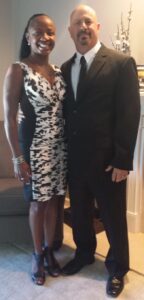 Dave and Charlena Leafer
Dave and Charlena LeaferIn May of 2008, Dave transferred one last time to serve as the Command Master Chief for Region Legal Service Office, Norfolk, the largest legal office in the Navy. He served as a trusted advisor to the commanding officer and provided leadership and mentoring for the command’s and the region’s ninety plus enlisted sailors. Dave retired from the Navy out of this position in June 2011, capping off a stellar thirty-year Navy career.
Dave has continued to serve the Navy as the civilian legal officer for the Navy Computer and Telecommunications Master Station in Norfolk, Virginia. His position allows him to stay in touch with the people he served with over his long career, as many of his best friends have similarly continued their association with the Navy after retiring.
With his travel significantly reduced since leaving active duty, Dave spends his free time enjoying life with his wife, Charlena, his three children, and his grandson. Although he’s battled some serious health challenges, he’s not let them slow him down or curb his enthusiasm. When he meets young people looking for adventure, travel, a way to pay for education, or just trying to find direction and discipline in their lives, he tells them to give the Navy a try and promises they won’t be disappointed. He adds with a smile, if he can make it, anyone can.
Voices to Veterans is proud to salute Master Chief Legalman David S. Leafer, U.S. Navy (Retired), for his many years of outstanding service to our nation, including during a wartime deployment on board USS Saratoga in Operation Desert Storm. Throughout his career, he not only provided outstanding legal services to sailors and the many commands he served in the fleet, but he also led and mentored countless Legalmen to help them be successful. For all he has done, we wish him fair winds and following seas.
November 11, 2020
Colonel Walter Joseph Marm, Jr., U.S. Army (Retired) – Battle of Ia Drang Medal of Honor Recipient
Every Soldier, Sailor, Airman and Marine wonders when the time comes, will they have the strength and courage to do their duty, even if it might cost them their life. Colonel Walter “Joe” Marm came face-to-face with that question as a young Army second lieutenant on November 14, 1965, in the elephant grass of the Ia Drang Valley in South Vietnam. For his answer, Joe Marm was awarded the Congressional Medal of Honor, America’s highest military decoration for valor in combat. This is his story.
Joe was born and raised in Washington County, Pennsylvania, about twenty-five miles southwest of Pittsburgh. His dad was a Pennsylvania State Policeman who spent his career in Washington County, while his mom stayed at home taking care of the family. Joe started school in a two-room schoolhouse where one teacher taught grades one through three while a second teacher taught grades four through six. After finishing second grade, Joe transferred to the Immaculate Conception parochial school in Washington County. There, the Irish nuns of the Mercy Order laid the foundation of a solid education that would carry Joe into college.
During his high school years, Joe was a member of the Frazier-Simplex Rifle Club. Shooting was a penchant he learned from his father, who was an expert pistol marksman competing for the Pennsylvania State Police. Joe used to help his father load cartridges for his father’s pistol. To participate in competitions with the club, Joe purchased a Winchester Model 52 target rifle and became quite proficient. He was also active in Boy Scouts until his troop disbanded, but not before he earned the rank of Life Scout and became a member of the Order of the Arrow. He credits the skills he learned in Boy Scouts and on the rifle team with preparing him well for the military.
Joe graduated from high school in 1959 and enrolled at Duquesne University in Pittsburgh to study pharmacy. His dad helped him get a construction job so he could earn money for school. He worked for bricklayers, loading up to twenty bricks on a “hod carrier”, which he hoisted onto his shoulder and then carried the bricks to the bricklayers who needed them. This was grueling work, as a fully-loaded hod carrier weighed about one-hundred pounds – even more when Joe carried mortar instead of bricks. One summer, they had Joe dig ditches for underground pipes feeding into the construction sites. His construction job paid $2.00/hour, a huge sum in the early 1960s. He earned even more one year working for the Jones & Laughlin Steel Company, sweeping floors and picking up trash in a steel mill.
Although Joe began his college studies majoring in pharmacy, he changed midway through to business. Normally, that change would have added a year onto his studies, but Duquesne waived the requirement that he participate in the Reserve Officer Training Corps, or “ROTC”, so he could catch-up with the required courses for his new major. Still, he knew the ROTC instructor well because the ROTC instructor coached the rifle team, which Joe participated on for three of his years at Duquesne. Joe also ran on the cross-country team during his senior year, helping him maintain himself in top physical condition.
As Joe prepared to graduate in June of 1964, his rifle team coach told him that since he was certain to be drafted, he should enlist in the Army under the college option, advising it would give him more control over his destiny. The coach told Joe if he liked the Army he could stay in, but if he didn’t, he could get out at the end of his hitch and go into business. Joe followed his coach’s advice, enlisting in the Army just five days after he graduated from Duquesne.
 Joe Marm
Joe MarmThe Army put Joe on a train to Fort Jackson, South Carolina, where he spent three days collecting gear and signing papers. He then loaded onto a bus with other new recruits headed for Fort Gordon, Georgia. When he got off the bus, he had to use the bathroom, so he approached a sergeant and said “sir”. He got no further. The sergeant cut him off very colorfully and informed him he was not a “sir”, he was a sergeant. Once that berating was over, Joe asked where the bathroom was, which set the sergeant off again. He informed Joe that the Army does not have bathrooms, it has latrines. Joe’s Basic training was off to a good start.
Basic training was tough. Joe and his fellow college option recruits lived in a World War II era barracks, which they had to maintain in spit and polish condition. They also did lots of running and “low crawling”, learning the art of soldiering. After Basic training, they continued on through Advanced Individual Training (AIT) for infantry and then finally to Officer Candidate School (OCS). At the time, OCS was geared primarily toward training existing enlisted soldiers to become officers. Because those enlisted soldiers already had a wealth of Army experience, the Army knew the college option candidates, who had no Army experience, would be at a significant disadvantage. To remedy this, Joe and his fellow college option recruits took extra classes at night and on weekends to learn about the Army and what it meant to be a leader.
Joe was given two choices for OCS, either infantry at Fort Benning, Georgia, or artillery at Fort Sill, Oklahoma. Given his Boy Scout and rifle team experience, Joe thought infantry would be the best fit. So, after completing AIT, he headed to Fort Benning in October 1964 where he joined a class of approximately 150 others seeking to become officers in the U.S. Army. Of those 150, approximately 60 were college graduates like Joe, while the remaining 90 were current enlisted soldiers whose superior performance had earned them the opportunity to become officers. The class was formed into six platoons of about twenty-five officer candidates each. The college graduates earned an E-5’s (sergeant) paycheck while at OCS, or about $145/month.
Like Basic training, OCS was very tough. The officer candidates lived in a cinder block barracks, got haircuts once or twice each week to make sure they maintained their regulation appearance, and had to spit shine the barracks’ floors every day. To make the floor shining job a little easier, they moved their bunks out from the wall and walked behind them, rather than in the common area in front of them where they might track in dirt that could be more easily seen. Whenever they marched between buildings in the battalion area, they did so in double-time, often carrying their M16 rifles at port arms. They weren’t alone in doing so, though. The battalion commander, Medal of Honor recipient Colonel Robert B. Nett, and all of the Training, Advising and Counseling (TAC) officers responsible for training the officer candidates, double-timed too, instilling in Joe and his comrades that great leaders lead by example.
As a direct result of Colonel Nett’s and the TAC’s leadership, Joe’s OCS class developed a deeply entrenched esprit de corps. The class, which was scheduled to graduate on April 19, 1965, was the 600th OCS class at Fort Benning since it was established there in 1941. In recognition of the milestone, every time the officer candidates sat down in their classrooms, they had to recite in unison “Six-hundred classes since ’41 tried, but none will compare to 4/65.” The refrain is still engrained in Joe’s mind after fifty-five years and the bond he and his classmates forged was so strong that they continue to meet at reunions every two years to this day.
After graduating from OCS and receiving his commission as a second lieutenant, Joe went to Army Ranger School, a tough nine-week course designed to significantly enhance a soldier’s warfighting skills. The school consisted of three phases: an initial three-week phase conducted at Fort Benning, a three-week mountain phase conducted at Camp Merrill, Georgia, and a three-week jungle phase conducted at Eglin Air Force Base in Florida. Once Joe completed this intense course, he was scheduled to attend Airborne training to earn his parachute jumping qualifications. However, with one week to go in the final phase of Ranger School in Florida, Joe and about forty other officers were told they were receiving orders to report to the 1st Cavalry Division, Air Mobile, at Fort Benning, Georgia.
The 1st Cavalry Division, Air Mobile, was then in the process of testing an entirely new warfare concept in exercises against the 82nd and 101st Airborne Divisions. Instead of parachuting troops onto the battlefield or transporting them on the ground, the 1st Cavalry Division, Air Mobile, deployed its forces by helicopter. This resulted in significantly greater maneuverability on the battlefield, allowing forces to quickly be inserted where they were needed most and quickly be withdrawn once their mission was accomplished. The exercises proved the validity of the Air Mobile concept, so the 1st Cavalry Division needed many new junior officers to fill platoon-level leadership positions in the new Air Mobile units. Joe and his fellow OCS and Ranger School graduates were in the right place at the right time for the assignment, so they reported to Fort Benning in July 1965.
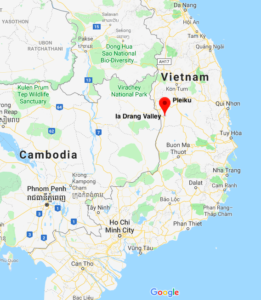 Ia Drang Valley in Vietnam
Ia Drang Valley in VietnamJoe was assigned to the 1st Battalion, 7th Cavalry Regiment, of the 1st Cavalry Division, Air Mobile. The 7th Cavalry had a long and storied history, having been the unit originally commanded by General George Armstrong Custer. Aside from the newly reporting officers, the men in the unit had been training with the new Air Mobile concept for almost two years. With their recent exercise successes against the 82nd and 101st Airborne Divisions, their morale and fighting spirits were high. Even more important for Joe, the 1st Battalion was commanded by Lieutenant Colonel Hal Moore, a 1945 West Point graduate and Korean War veteran. Lieutenant Colonel Moore was a dynamic officer who led by example and was a staunch proponent of the Air Mobile concept.
With only one month under his belt with the 7th Cavalry, Second Lieutenant Joe Marm and the rest of his unit boarded the World War II era merchant ship, USNS General Maurice Rose, in Charleston, South Carolina, bound for South Vietnam. They sailed through the Panama Canal and stopped in California but were not permitted off the ship. Once they left the West Coast, they stayed busy taking classes, attending intelligence briefs on the North Vietnamese Army and the Viet Cong, doing physical training, and practicing shooting at targets set up off the stern of the ship. Thirty-one days after leaving Charleston, and after sailing through a typhoon in the Pacific, they arrived in South Vietnam in mid-September 1965. They rendezvoused with their Division’s 400 helicopters, which had been ferried to Vietnam on Navy aircraft carriers, near the town of An Khe, which became the 1st Cavalry Division’s main operating base in the Central Highlands of South Vietnam.
With so many troops and helicopters now calling the 1st Cavalry Division’s base at An Khe home, the immediate priority was securing the facility from enemy attack. That meant Joe and the soldiers in his platoon had to patrol the base perimeter, sometimes as part of a full battalion conducting search and destroy missions looking for Viet Cong and North Vietnamese soldiers. This continued until November, when intelligence reported that the North Vietnamese Army had established a base in the Ia Drang Valley, about thirty miles southwest of the provincial capital of Pleiku. The base, which was on an around Chu Pong mountain, was to be used as a jumping off point for a North Vietnamese attack on Pleiku. To keep that from happening, the 1st Battalion of the 7th Cavalry was ordered to insert into and secure the Ia Drang Valley, sweeping the valley clear of North Vietnamese forces. The ensuing engagement was not only the first major battle between U.S. and North Vietnamese soldiers, but it also served to prove the effectiveness and utility of Air Mobile forces.
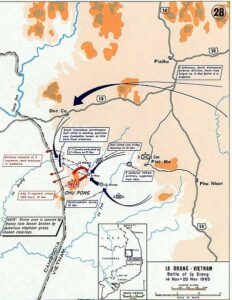 Map of Battle of Ia Drang – Source: U.S. Department of Defense
Map of Battle of Ia Drang – Source: U.S. Department of DefenseOn the morning of November 14, 1965, Lieutenant Colonel Hal Moore flew with Bravo Company from the 1st Cavalry Division’s base at An Khe onboard sixteen UH-1 “Huey” helicopters and disembarked at Landing Zone X-Ray in the Ia Drang Valley. Bravo Company initially set up perimeter security until Joe’s Company – Alpha Company – arrived with the next flight of sixteen Hueys. Under the direction of Joe’s Company Commander, Captain Tony Nadal, Joe and his platoon took up defensive positions around the landing zone, allowing Bravo Company to move out in search of the enemy.
As Bravo Company started to engage the enemy with small arms fire, one platoon from Bravo Company with about thirty-five men moved forward in fast pursuit and got separated from the rest of the Company. They soon became cut off and were in danger of being annihilated. In the meantime, a runner came to Joe’s position and gave him a message that his company commander had been wounded and Joe was in charge. Having been prepared for situations like this at Ranger School, Joe told his platoon sergeant to take over and made his way to the Alpha Company command post. When he arrived, he saw his company commander talking on the radio. That’s when Joe realized the runner had said, “if the company commander is wounded, you are in charge”, and he’d not heard the word “if”. It was the fog of war in action.
Joe made his way back to his platoon with orders to report to Bravo Company to assist in breaking through to the lost platoon. They made an initial assault, which the North Vietnamese regulars repelled.
By now, Charlie Company had arrived at Landing Zone X-Ray, taking over the base perimeter positions and freeing up all of Alpha Company to join in a second assault to reach the lost platoon. After an artillery barrage late in the afternoon to help dislodge the enemy, Alpha and Bravo Companies pushed forward through the tall elephant grass until they were forced to take cover from heavy enemy fire. After Joe’s platoon killed four enemy soldiers seeking to dislodge them from their position, Joe saw that they were coming under fire from somewhere in front of them. To allow his men to pinpoint the source, Joe exposed himself to the fire.
Joe’s actions allowed his platoon to locate a machine gun about thirty to forty meters directly in their front, perched on an eight or nine-foot high ant hill fortified with rocks. After one of his soldiers tried unsuccessfully to fire a light antitank weapon (LAW) at the target, Joe took the LAW and launched a rocket directly into the mound, resulting in a loud explosion. The blast gave him and his platoon a morale boost, but the machine gun remained in action at the top of the ant hill. Using sign language, Joe directed one of his soldiers to take out the machine gun emplacement with a grenade. The soldier thought Joe meant throw the grenade from his current position, which he did. The grenade fell short, blowing up without any effect.
It was getting late in the afternoon and Joe knew his platoon couldn’t move forward without neutralizing the machine gun. Realizing he needed to take matters into his own hands, he told his men to hold their fire. He then charged directly into the machine gun’s field of fire, crossing thirty meters of open terrain until he was in front of the ant hill. He tossed a grenade over the mound, destroying the machine gun. He then made his way around the mound and using his M16 rifle, single-handedly took out the remaining North Vietnamese soldiers still maintaining their position.
With the machine gun and its defenders neutralized, Joe turned and signaled his men to move forward. Moments later, he felt the searing pain of a bullet smashing through his left jaw and exiting through his neck on the right. Fearing the worst, he checked inside his mouth to make sure he still had teeth. One of his sergeants, who had been a medic in Korea, ran up to him and patched him up enough to allow two of his men to get him back to the landing zone.
For Joe, the battle was over, but for the rest of the 1st Battalion, as well as for elements of other Cavalry units, the battle would rage on for two more days. The lost platoon was rescued, but only after many of its members were killed or wounded. The human cost of the battle for the 7th Cavalry was 79 soldiers killed and 121 wounded. North Vietnamese losses were estimated to be about ten times those numbers. U.S. air power and the tenacity of the 7th Cavalry soldiers proved to be the deciding factors in the tactical U.S. victory, but just a few miles away on November 17 at another landing zone, Landing Zone Albany, the North Vietnamese claimed a tactical victory of their own by forcing the 7th Calvary’s 2nd Battalion to withdraw after sustaining significant casualties in close-quarter fighting where U.S. air power could not be brought to bear.
Joe was medically evacuated from Vietnam and sent to Valley Forge General Hospital, an Army hospital located about twenty-seven miles from Philadelphia, to recuperate. The Army chose the location so Joe would be close enough for his family to visit. For the first three months, he ate nothing but baby food as his jaw was wired shut. However, by the middle of February 1966, he had recovered sufficiently to be released from the hospital. The Army gave him orders to return to the Ranger School at Fort Benning, this time as an instructor. Because he was a bachelor, they assigned him to the mountain phase of the training at Camp Merrill, where family housing was in short supply. While there, Joe received a letter from his former company commander, Captain Nadal, who was still in Vietnam, telling him the unit had recommended him for “a very high award.”
Joe subsequently participated in an award ceremony for Vietnam veterans hosted by a minor league baseball team in Florida. Joe received the Silver Star, the nation’s third-highest award for gallantry in action and personal heroism. This confirmed for Joe what his company commander had told him and he was honored and humbled to receive the award. It wasn’t until sometime later that a reporter from Saga Magazine called Joe and asked for an interview that Joe learned he had been recommended for the Congressional Medal of Honor.
On December 19, 1966, Secretary of the Army Stanley R. Resor presented Joe with the Congressional Medal of Honor at a ceremony held at the Pentagon’s river entrance. In addition to many generals and other senior military officers from the Pentagon, the Army flew in veterans of the Battle of Ia Drang from Fort Benning so they could see their comrade honored. The Army also sent a plane to Pittsburgh to pick up Joe’s family so they could watch the ceremony, as well. Joe remembers being in shock at the ceremony. Here he was, a young Army first lieutenant, meeting all of the Army’s top officers and leaders. He had his picture taken with the Army’s Chief of Public Affairs, Major General Keith Ware, himself a Medal of Honor recipient from World War II. Major General Ware was subsequently killed in action in September 1968 when his helicopter was shot down in Vietnam during the Battle of Loc Ninh.
Joe was the seventh recipient of the Medal of Honor from the Vietnam War. Of those first seven, Joe and two others received the honor in person, while the other four recipients received the honor posthumously. In Joe’s view, his actions on November 14, 1965, were no greater than those of the many men who fought alongside him. He considers himself grateful to be authorized to wear the medal on their behalf.
Joe’s Army career did not end in December 1966. In fact, it was just beginning. As a Medal of Honor recipient, he could have served out the rest of the Vietnam War stateside. Instead, he felt obligated to return to Vietnam to be with his fellow soldiers who were carrying on with the war effort. Once he put in his request, the Army had him sign papers acknowledging he did not have to return to Vietnam and clearly stating that he was volunteering to do so. Once that was complete, Joe found himself back on a plane heading to war for a second time.
Now a captain, Joe was once again assigned to the 1st Cavalry Division. He was initially attached to the 1st Brigade Headquarters at Tay Ninh, near the border with Cambodia, as the S3 Air Operations Officer, arranging air strikes in support of troops on the ground. He later took command of a rifle company in the 1st Battalion, 8th Cavalry, providing security for the base. After completing his rotation as company commander, he rounded out his second tour in Vietnam by serving as the Battalion’s S2 Intelligence Officer.
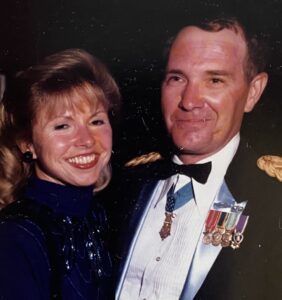 Joe and Deborah Marm
Joe and Deborah MarmJoe’s post-war assignments were many and varied. The Army sent him to the University of Georgia, where he earned a master’s degree in psychology. He later served as a battalion commander at Fort Benning and spent the last few years of his career advising and training troops in the Army Reserve. He found his tours with the Army Reserve particularly eye-opening, watching the dedicated soldiers in the Reserve maintain their military readiness while still balancing their family life and their civilian jobs. Joe finally retired in 1995 at the rank of colonel after thirty years on active duty.
After retiring from the Army, Joe and his wife, Deborah, settled in Deborah’s hometown, Fremont, North Carolina, where they restored an old family home built in 1904. Joe also worked full-time with Deborah’s family’s hog farm. Today, Joe and Deborah are enjoying retirement together in small-town Eastern North Carolina.
Voices to Veterans is proud to salute Colonel Walter Joseph Marms, U.S. Army (Retired) for his incredible heroism during the Vietnam War and for his life of service to our country. He represents the best our country has to offer, humbly wearing the Medal of Honor on behalf of the men he fought alongside during the Battle of Ia Drang in 1965. Grateful for all he has given, we wish him fair winds and following seas.
Postscript: Read more about the Battle of Ia Drang in We Soldiers Once…and Young by Lieutenant General Harold G. Moore and Joseph L. Galloway. The book was subsequently made into a move, We Were Soldiers, starring Mel Gibson as Lieutenant Colonel Hal Moore.
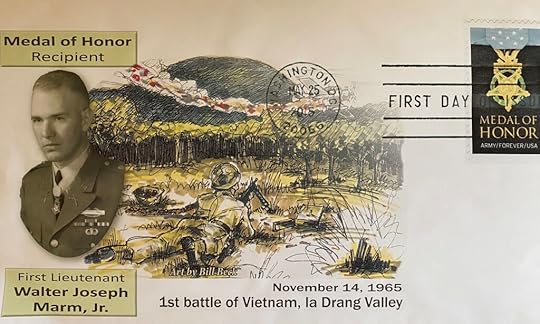
October 7, 2020
Sergeant First Class Alan L. Boyer, U.S. Army – Missing in Action for 48 Years But Never Forgotten
When you are twenty years old, you feel invincible and ready to change the world. Your entire life lies before you, just waiting for you to unlock the door that will lead to your future. When it came time for Sergeant First Class Alan Boyer to choose, he never hesitated. He loved America, he loved freedom, and he loved democracy more than life itself. He chose to enlist in the Army at the height of the Vietnam War because every fiber in his being told him it was the right thing to do. Two years later, he and three other soldiers were left behind during a covert mission in Laos, leaving his family to wonder what had happened for 48 years. This is Alan’s story as told by his sister, Judi Boyer Bouchard.
Alan was born on March 8, 1946, in Chicago, Illinois, to Charles and Dorothy Boyer. Judi was three years younger than Alan and was his only sibling. Their family moved frequently within Illinois because of Alan’s dad’s job. Always focusing on the positive, Alan’s dad told his kids the moves were good because they gave them the opportunity to make lots of friends. Since Alan was naturally gregarious and a leader, he proved his dad correct. In fact, when Alan began at his third high school in four years, MacArthur High School in Decatur, Illinois, he met his very best friend, Doug Hagen, who would also later serve in the Army.
During the summers, Alan loved camping with his family, especially out west. They visited most of the western national parks, prompting Alan to get a summer job at Yellowstone National Park. He enjoyed it so much that after he graduated from MacArthur High School in June of 1964, he attended the University of Montana in Missoula, pursuing a degree in forestry. He also joined Theta Chi fraternity, making lots of friends and enjoying college life in Missoula, but there were storm clouds on the horizon. As the Vietnam War escalated in 1965, President Johnson sent more and more troops to South Vietnam to keep communist North Vietnam from overrunning its neighbor to the south.
Alan could not sit on the sidelines—he had to do his part. His father served in the Navy during World War II and their family had a strong sense of allegiance to the United States. If the United States needed young men to help defend America’s allies and promote freedom around the world, Alan was ready. He spoke to his parents, who were now living in Rockford, Illinois, and told them he had to take a break from his studies to enlist in the Army. His parents knew the risks, but they also knew how they had raised Alan and were proud of his commitment. They told him it was his decision and gave him their blessing, with the understanding he would return to the University of Montana to finish his degree as soon as he completed his service.
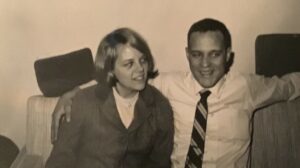 Alan Boyer and his sister, Judi, in 1967
Alan Boyer and his sister, Judi, in 1967Alan enlisted in the Army in early 1966. He attended Basic Training at Fort Ord, California, and did follow-on Advanced Infantry Training (AIT) there, as well. After Fort Ord, he transferred to Fort Benning, Georgia, for Airborne training, where he learned basic paratrooper skills. From there it was on to Fort Bragg, North Carolina, for special forces training, where he earned the right to wear the Army Special Forces green beret.
Alan took leave two times in 1967 to visit his family. In June, he made it to Judi’s high school graduation in Rockford, Illinois. Then, after Judi followed in Alan’s footsteps and began her freshman year at the University of Montana, Alan visited Judi in Missoula and spent a week with her and those of his fraternity brothers still there. Alan’s Missoula visit is etched in Judi’s memory, not only because she adored her big brother and was thrilled he would take the time to spend an entire week with her, but also because it was the last time she would see Alan. After they said goodbye at the end of the week, Alan left for Fort Lewis, just outside of Tacoma, Washington. He was on his way to Vietnam.
Once in Vietnam, Alan was assigned to the 5th Special Forces Group, which provided highly-trained special operations soldiers to the Military Assistance Command, Vietnam – Studies and Observations Group (MACV-SOG) to conduct top-secret unconventional warfare missions. MACV-SOG, which employed special operations forces from all of the military services, worked closely with the CIA to conduct clandestine missions in North and South Vietnam, Laos and Cambodia. Missions in Laos were particularly sensitive because the United States would not admit to conducting operations there. The missions were crucial to interdicting the massive amounts of supplies the North Vietnamese funneled south along the Ho Chi Minh Trail, which ran through Laos along its eastern border with South Vietnam.
Typical MACV-SOG missions into Laos consisted of inserting a team of three U.S. special forces troops, together with up to twelve local operatives. The team would reconnoiter North Vietnamese activity, call in air strikes on enemy targets, and extract by helicopter, all without being detected. Other missions included insertions into enemy territory to rescue downed pilots, sorties to capture North Vietnamese soldiers to gain critical intelligence, and small team interdiction missions.
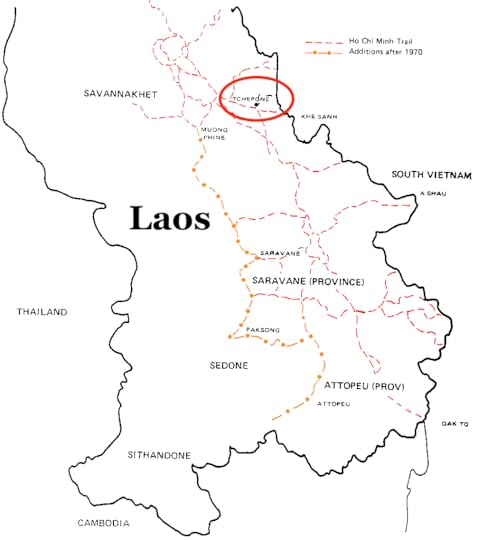 The Ho Chi Minh Trail and Tchepone in Laos. Source: U.S. Army Center of Military History
The Ho Chi Minh Trail and Tchepone in Laos. Source: U.S. Army Center of Military HistoryOn March 28, 1968, Sergeant Alan Boyer was on one such classified reconnaissance mission near the Ho Chi Minh Trail in the jungle-covered mountains of Laos about twelve miles northeast of Tchepone, a village in the Savannakhet province. His team included Sergeant George R. Brown, Sergeant Charles G. Huston, and eight South Vietnamese soldiers. Late in the morning, the team came under fire from a larger enemy force and requested to be extracted, but when the helicopter arrived, it could not land because of the rugged terrain. Running out of time, the helicopter lowered a rope ladder into the jungle and the South Vietnamese soldiers began climbing up and into the chopper. With the eight South Vietnamese either in the helicopter or climbing to safety, Alan started climbing the rope ladder to make his escape. At the same time, the rescue helicopter came under heavy automatic weapons fire, forcing it to disengage. As it did, either the mounting brackets for the rope ladder were shot away or rope ladder broke after getting tangled in the jungle foliage and Alan and one South Vietnamese soldier fell to the ground. As the helicopter departed, its crew observed Sergeants Brown and Huston defending their position. Alan’s status, and that of the remaining South Vietnamese soldier, was unknown.
On April 1st, a search team deployed to the extraction site to locate the four team members left behind. No trace could be found. They were declared missing at a classified location, which was not disclosed. Alan’s parents received the following telegram a few days later: “We regret to inform you that your son, Alan L. Boyer has been listed as Missing in Action. Do not share this information with anyone other than immediate family. To do so could endanger his safety.” Several days later, two Army officers visited, but could not disclose any of the details of Alan’s disappearance. The inference Alan’s mother and father drew was Alan had been captured, so they held out hope for his return.
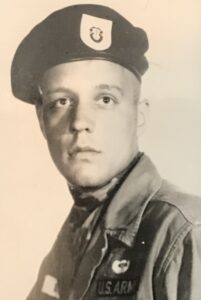 SFC Alan L. Boyer, U.S. Army
SFC Alan L. Boyer, U.S. ArmyWhen Judi’s parents gave her the news, she was devastated, but she, too, held out hope Alan had been captured and would return. She had written him nearly every day since he had been in Vietnam and he had written her many letters in return. He was never able to say what he was doing or where he had been, only telling her it was scary. She knew, though, he had been trained in escape and evasion, and he was smart and in excellent physical condition. If anyone could survive, he could.
Judi went on to graduate from the University of Montana in 1970 and after a short trip home, returned to Missoula to work for the university. When the Vietnam War finally ended in January of 1973, the Paris Peace Accords included provisions for repatriating prisoners of war (POWs) held by North Vietnam. In the days leading up to their release, Alan’s parents received another telegram from the Department of Defense, this time indicating Alan would not be among the 591 POWs being released. Judi remembers as a bittersweet moment watching on TV the liberated U.S. POWs walking down the stairs leading from the C-141 transport aircraft that brought them out of Vietnam. She was so happy for the release of the American heroes but prayed as each plane emptied, “Please Lord, just let one more man walk off that plane. Please, let Alan be one of them.” Alan’s homecoming was not to be.
To help keep a flicker of hope alive and to gain strength and support from one another, the families of American POWs and those missing in action (MIAs) formed the National League of POW/MIA Families. Alan’s mother, Dorothy Boyer, joined the organization early on and was very active. Judi joined and was active too, and together with the other members, visited their representatives in Congress and officials at the Pentagon in Washington, D.C., to promote POW/MIA awareness and make sure everything possible was being done to account for all service members still missing in Southeast Asia. They even had breakfast with President Ronald Reagan at the White House.
In the years that followed, the Department of Defense never gave up looking for Alan and Sergeants Brown and Huston, even though they had little cooperation from the Vietnamese and Laotian governments. In 1984, a Laotian refugee reported three Americans being killed and buried in the area where Alan had been left behind, but subsequent searches uncovered nothing. In 1992, the Department of Defense established Joint Task Force—Full Accounting (JTF-FA) to obtain the fullest possible accounting of those still missing from the Vietnam War. That same year, a joint U.S./Lao team traveled to the area where Alan was last seen after two local Laotians reported seeing three men fall from a helicopter in 1968. The witnesses indicated the Americans had been buried by local militia, but no remains were found. Then, in 1995, the U.S. formally restored diplomatic relations with Vietnam. Still, Alan’s case remained open. Alan’s father died in 1994, not knowing what had happened to his son.
In 2001, investigators found a tooth at an excavation site in the vicinity of where Alan’s team had been lost. Dental records linked the tooth to Sergeant George Brown and he was declared killed in action. This brought no closure to Judi because nothing about the tooth’s discovery gave any indication of what happened to Alan. She held out hope news of Alan would be found, and, after learning tour groups were now going to Vietnam and Laos, determined she and her mother would visit Laos to see what they could find out.
Judy and her mother, then 81, made the trip to Laos later in 2001. When they arrived in Vientiane, and with no advance warning, they called the U.S. embassy to see if anyone would talk to them about Alan. Their call was transferred to the Officer-in-Charge of JTF-FA Detachment Three, which worked at the embassy. Not only did the Officer-in-Charge say yes, but he also brought Judi and Dorothy to his office to talk about the detachment’s efforts and treated them to lunch. What made the biggest impression, though, was a huge photograph of the excavation site of Alan’s last known location hanging on his office wall. Since the Officer-in-Charge had no way of knowing Judi and Dorothy were visiting Laos, let alone the embassy, it gave Judi great comfort to know her brother’s case was still front and center of the detachment’s MIA recovery efforts. The trip uplifted both Judi and her mom and helped keep their hope alive.
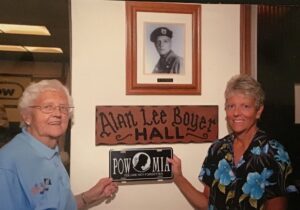 Dorothy Boyer and Judi Bouchard Boyer
Dorothy Boyer and Judi Bouchard BoyerYears passed and both Judi and her mother remained active in the National League of POW/MIA Families. In May of 2013, Dorothy passed away at the age of 92, still not knowing what had happened to her son. Then, a miracle occurred. On March 7, 2016, the night before Alan’s 70th birthday, Judi took a phone call from Michael Mee of the Army’s Casualty Operations Center. He told Judi three Lao nationals had turned in a bone fragment they found and the DNA from the fragment matched DNA samples Judi and her mother gave years before. Judi finally knew for certain Alan had been killed in Laos and she could have a proper burial for him at Arlington National Cemetery.
Lieutenant General Mike Linnington, U.S. Army (Retired), then the Military Deputy to the Under Secretary of Defense (Personnel and Readiness) and now the Chief Executive Officer of the Wounded Warrior Project, flew to Florida to meet with Judi to help make the funeral arrangements. During the course of Judi’s discussions with General Linnington, she mentioned Alan’s best friend from MacArthur High School, Loren “Doug” Hagen, had also served in the Army as a First Lieutenant after graduating from North Dakota State University with a degree in engineering. Judi relayed the reason Doug joined the Army was to go to Vietnam to find out what had happened to Alan. Amazingly, Doug was assigned to MACV-SOG, just as Alan had been, but he never found out what happened to Alan because Doug was killed in action on August 7, 1971, leading troops in action deep within enemy-held territory. For his bravery under fire and disregard for his own personal safety, Doug was posthumously awarded the Congressional Medal of Honor. Alan was also posthumously decorated for personal bravery and gallantry in action against the enemy, receiving our nation’s third highest honor, the Silver Star, as well as the Purple Heart.
When it came time for Alan’s funeral with full military honors at Arlington on June 22, 2016, Judi was not sure whether many people would be able to attend given so many years had passed since Alan went missing in the far off jungles of Laos. To her amazement, over 100 people attended, including friends of Alan’s from MacArthur High School and his fraternity at the University of Montana, as well as special forces soldiers honoring the homecoming of one of their own. Even more amazing, Alan was being buried near his best friend, Doug Hagen. Now, the two comrades in arms could forever rest in peace together. Judi found peace, too, knowing her beloved brother was finally home.
Retired and living in Florida with her husband, Ron Bouchard, Judi remains a staunch supporter of veterans and ongoing efforts to account for the 1,586 Americans still unaccounted for from the Vietnam War (including Alan’s teammate, Sergeant First Class Gregory Huston, who recently had a stretch of Route 66 in Shelby County, Ohio, dedicated to his memory). She is active in the National League of POW/MIA Families, traveling to Washington, DC, annually to make sure lawmakers are aware of and address POW/MIA issues. She is also a proud member of the American Legion. Above all, she wants others to know what a wonderful brother Alan was and that he died serving the country he loved so much.
Voices to Veterans is proud to salute Sergeant First Class Alan L. Boyer, U.S. Army, for his selfless service to our country during the Vietnam War. The freedom we enjoy today is the legacy of his service and ultimate sacrifice. Voices to Veterans also salutes his sister, Judi Boyer Bouchard, for keeping Alan’s memory alive. When our nation called, Alan answered and gave it his all. May we all learn from his example.
September 2, 2020
Staff Sergeant Jim Belshaw, U.S. Air Force – Military Working Dog Handler in the Vietnam War
Serving in the U.S. Air Force changed the trajectory of Staff Sergeant Jim Belshaw’s life. He entered the military with a vague idea of what he was looking for, but left eight years later with a firm purpose in mind. He saw every experience, from talking to fellow Airmen to guarding the perimeter of an air base in the Thai jungle during the Vietnam War, as an opportunity to learn and grow. This is his story.
Jim was born on the South Side of Chicago and remains a die-hard White Sox and Bears fan to this day. His father died four weeks after Jim’s eighth birthday and his mother remarried two-and-a-half years later. Jim’s new stepfather came from farming country in southern Illinois. He was not comfortable in Chicago, so he moved his new family about 65 miles southeast to the small town of La Porte, Indiana.
Although Jim’s stepfather was happy with the move, Jim was not. Having come from the hustle and bustle of Chicago’s South Side, he was not well-suited for small town life and didn’t like it. In fact, he couldn’t wait to leave and saw the Air Force as his ticket out. He graduated from La Porte High School in June of 1962 and shortly thereafter enlisted in the Air Force. His goal was to get into law enforcement, which at the time was known as the Air Police.
Jim reported for boot camp at Lackland Air Force Base in San Antonio, Texas. The July heat was so intense, he wondered what he was thinking when he decided to enlist in the summer. Despite the heat, he did well and managed to avoid the ire of his drill instructor, although on one occasion, he came close. Sometime around week six of the eight-week Basic Training, the drill instructor burst into the barracks for a surprise footlocker inspection. As the trainees popped to attention at the end of their bunks, the drill instructor made a beeline for Jim, got into his face, and said “Open your locker, Fox.” Jim replied, “Yes drill instructor, but I’m not Fox.” Fox was another trainee in the flight who looked like Jim. “What did you say?” the drill instructor barked. Jim repeated, “Yes, drill instructor, but I’m not Fox.” Someone on the other side of the room said, “That’s not Fox. He’s over here.” Not skipping a beat, the drill instructor left Jim and went over to the real Fox and dumped his footlocker on the floor. While feeling bad for Fox, Jim was thrilled he’d escaped the drill instructor’s wrath. He was even more thrilled that six weeks into Basic Training, the drill instructor didn’t know who he was, which meant he must be doing okay.
After Basic Training, Jim started in Air Police School, which was also at Lackland Air Force Base. It was there that he learned that only about 10% of the Airmen in his class would actually get law enforcement jobs after completing the training, while the other 90% would work in base security, which meant protecting Air Force bases and facilities around the world and keeping the aircraft and people on the base safe. Jim was part of the 90%, and after graduating from Air Police School in December 1962, he reported to an air base in the United Kingdom (UK) known as Royal Air Force (RAF) Woodbridge which, together with nearby RAF Bentwaters, were home to the U.S. Air Force’s 81st Tactical Fighter Wing. Jim was assigned to the 81st Air Police Squadron, which provided security for the U.S. jet fighters and weapons stored at the base.
Jim found his duties incredibly boring until about eight or nine months into his tour. One night, he was standing guard at the gate leading to the flight line where four armed and ready fighters were parked when a fellow Airman on a roving K-9 (dog) patrol approached him. The Airman told Jim he was going home in three weeks and couldn’t wait. Then he asked Jim if he’d ever considered working with K-9s. Jim said no and the Airman replied he should. He added all the people who make your life hell will stop because they’re scared of the dogs. That was all Jim needed to hear. The next morning, he volunteered for K-9 duty.
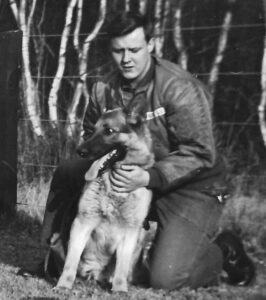 Jim with Rinty at RAF Woodbridge
Jim with Rinty at RAF WoodbridgeThree weeks later, Jim’s unit sent him to the RAF Police Dog Training School at RAF Debden, located about fifty miles north of London. Not only did the Air Force send its Air Police dog handlers to be trained at the RAF school, but it also leased working dogs from the RAF because the UK had a strict six-month quarantine on dogs brought in from the United States. Upon reporting, Jim and a fellow Airman from New York City checked into the U.S. side of the student barracks. A little while later, they met some RAF Airmen heading to the UK side of the student barracks. Jim and his friend invited the RAF Airman to visit them but the UK students said they were forbidden from entering the U.S. side. Thirty minutes later, Jim and his friend had the UK students drinking beer with them and playing blackjack on the U.S. side.
Jim really enjoyed his time at the school and says tongue in cheek that it wasn’t long before all of the RAF corporals or below loved him and everyone above the rank of corporal wanted him court-martialed. Because they were near U.S. facilities that had a base exchange, he could purchase cigarettes, beer and whiskey cheaply and bring them back for parties at the school. He would make a run every Saturday, even taking orders to make sure he came back with what people wanted. The friendships and the fun made the two-month school pass by quickly.
Jim describes the sentry dogs they trained with as “bad dudes” and highly aggressive. The dogs had to be kept on a lead at all times because they were literally trained to attack anything that moved. It was not uncommon for a dog to turn on its handler, especially if the handler was trying to get the dog to release someone playing the bad guy in a leather padded attack suit. All handlers had scars on their hands from where the dogs had left their mark.
One other aspect of the training that stood out for Jim was that all of the upkeep, feeding, grooming, cleaning and care for the dogs was assigned to young enlisted women from the Women’s Royal Air Force (WRAF) whose official job title was Kennel Maid. Despite having to deal with the aggressive dogs in much the same way as their male counterparts, military women were not permitted to be dog handlers in the UK until 1989. The U.S. Air Force opened the dog handler field to women in the mid-1970s, and Jim was glad to see the barriers to women lifted in both cases.
After completing his tour at RAF Woodbridge in December 1965, Jim was discharged from the Air Force and went back to live with his family in La Porte, Indiana. Just as he didn’t like it when he was a teenager, he continued not to like it now. His aversion for the area was exacerbated by having been on his own for almost four years, including having lived in the UK. Bored in La Porte and missing his time in the Air Force, he reenlisted in the fall of 1966 for four more years.
Now a Senior Airman, Jim was sent to the 687th Aircraft Control and Warning Squadron. The unit, which trained new second lieutenants to be air controllers for follow-on duty in Vietnam, was located on the high desert approximately ten miles west of Albuquerque, New Mexico, at a secluded radar site called West Mesa Air Force Station.
Jim was the only security person on the installation, which was fine because nothing bad ever happened. He described it as the closest thing to the TV show MASH he experienced during his time in the Air Force. He says if the Air Force had given him the opportunity to stay there for ten years, he would have accepted. There were only about one-hundred persons working at the facility, ten officers and ninety enlisted. Because the location was remote, military protocol was loose and the installation commander and the First Sergeant often left at 12:30 to play golf. Even better, the food was superb. So good, in fact, that generals and colonels from Kirkland Air Force Base in southeast Albuquerque would come to experience steak night on Tuesdays, Mexican food night on Thursdays, and lobster night on Fridays.
Beyond the amenities, Jim’s assignment at West Mesa was life-changing. While there, he met three enlisted Airmen, all with Masters Degrees, having enlisted in the Air Force for four years after graduate school to avoid being drafted into the Army or the Marine Corps. When one of them read a report Jim had written, he asked where Jim had gone to college. When Jim said he’d not gone to college, his new friends could not believe it. They insisted he enroll in an English 101 night course at the University of Albuquerque, which he did. Jim surprised himself by doing well. So well, in fact, that it gave him the confidence to take another course as soon as the next semester started. He excelled again and at that point he decided that once he was discharged, he would pursue his college degree, something he did not have the confidence to do before his three friends encouraged him. The seeds of his future were sown.
West Mesa Air Force Station closed in 1968 and Jim was one of the last persons to leave. He transferred to Oxnard Air Force Base in Southern California, where for the second tour in a row he worked in security without dogs. His initial responsibilities involved driving a pickup truck around the base to make sure the security details were properly posted at the start of each shift. His job changed for the better one night when the shift Technical Sergeant asked if there was anyone who knew how to type. Jim raised his hand and was immediately assigned as the desk sergeant working in the Security Operations nerve center because he could type the police reports and the daily crime blotter. The assignment proved to be a great opportunity and he was grateful his high school typing teacher, Ruthie Huddleston, had made him learn how to type.
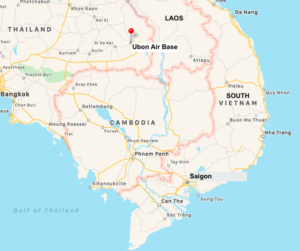 Ubon Air Base in Thailand
Ubon Air Base in ThailandIn 1969 Jim received orders to report to the U.S. Air Base in Da Nang in the Republic of South Vietnam. During his pre-deployment physical, the doctors discovered torn cartilage in one of Jim’s knees, probably the result of his dog training. He underwent corrective surgery, but when he fully recovered, he was sent to the 8th Security Police Squadron at Ubon Air Base in Thailand, rather than to Da Nang as originally planned.
The Air Force used Ubon Air Base to support special missions against the North Vietnamese. One major focus of the aircraft based there was to disrupt the flow of men, weapons, equipment and supplies down the Ho Chi Minh Trail in southern North Vietnam and in Laos. The nighttime interdiction missions, referred to as Blind Bat missions, consisted of an unarmed C-130 dropping flairs on an area of suspected enemy activity, followed by a heavily armed C-130 gunship peppering the area with fire, while F-4 fighters flew cover overhead. Because the missions were taking a heavy toll, the North Vietnamese tried to infiltrate Ubon Air Base on three occasions using sappers to sneak through base defenses in order to destroy the U.S. aircraft there.
Jim arrived at Ubon Air Base in September of 1969, just a couple of months after the first sapper attack. That attack, which occurred on July 28th, 1969, resulted in a K-9 handler and his dog both being wounded as they engaged the sappers escaping from the base after damaging several aircraft. Jim was there for the second attack, which occurred at approximately 2:00 a.m. on January 13, 1970. K-9 sentries played a key role in repelling the attack, which lasted about 25 minutes. In the end, one K-9 handler and his dog were wounded, and another dog, King, was killed after repeatedly attacking a sapper closing in on a C-130 gunship. All of the sappers were killed. The third and final sapper attack occurred in 1972, long after Jim had returned to the United States.
The sapper attacks proved Jim and the other sentries had to be vigilant at all times and that they were engaged in deadly serious business. By this time, Jim was now a Staff Sergeant in charge of one of the two flights (shifts) of K-9 sentries. At the start of Jim’s twelve-hour shift, which began at 6:00 p.m., Jim would load all of the sentries and their dogs into the back of a truck and then drop them off, one at a time, at their posts for the evening. He would also resolve any issues that came up with his team, like men or dogs getting sick or injured, and make sure all of the sentry posts were covered.
With six months left of Jim’s one-year tour at Ubon, the non-commissioned officer (NCO) in charge of training informed him he needed to complete certain training. Jim told him that he would be getting out of the Air Force as soon as he returned to the States, so there was no need to waste the training on him. The NCO agreed and Jim thought that was the end of it. After his night shift the next morning at 10:00, Jim was awakened by his Master Sergeant yelling, “So you don’t want to progress.” Jim asked the Master Sergeant what he was referring to. The Master Sergeant replied, “Well, the Air Force don’t want NCOs who don’t want to progress. From now on, you get a dog and you’re on the perimeter.”
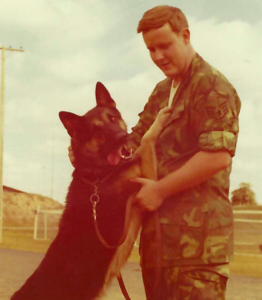 Jim with Nick at Ubon Air Base
Jim with Nick at Ubon Air BaseNow Jim knew what the Master Sergeant was talking about. When he told the training NCO the day before that they didn’t need to waste the training on him because he was getting out, it meant he would not be eligible for promotion. Accordingly, the Master Sergeant took his leadership position away and reverted him to standing sentry duty. This lasted for six weeks, until the Master Sergeant had an apparent heart attack and was medically evacuated from Ubon. Jim was given his flight of K-9 sentries back, which he continued to lead until he departed Thailand.
Jim’s plan was to depart Ubon at the end of August 1970 so he could enroll at the University of New Mexico for the fall semester. This meant he had to leave before his scheduled departure date of September 2nd, which required special permission from a very stern and non-compromising Lieutenant Colonel. When Jim asked her if he could depart, she denied his request. He told what had happened to a young F-4 fighter pilot doing a rotation through the unit and, somehow, the junior officer got Jim orders to depart on August 30th, which he did. Less than sixty hours later, Jim was in Albuquerque enrolled at the University of New Mexico, majoring in journalism.
Jim graduated from the University of New Mexico in December 1973 and took a job with the Las Cruces Sun-News. A year later, he jumped to the Albuquerque Journal, where he stayed until the University of New Mexico offered him a position in its Public Affairs Office in August 1975. He worked there for two years until he again heard the siren call of the Albuquerque Journal. He took a position as an Assistant City Editor and also became the Feature Editor when that position became vacant six months later. He is best known for the popular columns he wrote three to four times each week probing deep into the human experience hidden below most headlines. His columns appeared until he retired in 2009.
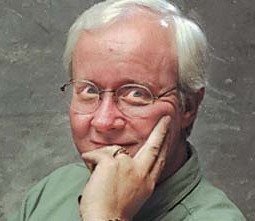 Jim on the Albuquerque Journal staff
Jim on the Albuquerque Journal staffJim also wrote freelance stories for the Vietnam Veterans of America (VVA) Magazine and covered two historic visits by Vietnam veterans to Vietnam in 1994 and 1995. These visits were instrumental in thawing and normalizing relations between the United States and Vietnam, which just twenty one-years before had been mortal enemies on the battlefield. Jim would go on to write numerous pieces for the VVA Magazine over the next twenty years on a wide range of topics, including Agent Orange, member profiles, and teaching about the Vietnam War.
Over the years, Jim received many accolades for his journalism. His awards include the Distinguished Graduate Award from the University of New Mexico, the ACLU First Amendment Award, the Anti-Defamation League Journalism Award, several New Mexico Press Association Awards, and the Albuquerque People’s Choice Award. He also authored three non-fiction Books: two collections of his columns and one about a dying young doctor and how his experience as a patient changed his views on the practice of medicine.
Now retired and living with his wife near Albuquerque in Corrales, New Mexico, Jim continues to be passionate about veterans’ issues and is a card-carrying member of the Vietnam Dog Handler Association. In fact, he and his wife share their house with a German Shepherd and an Australian cattle dog.
Voices to Veterans is proud to salute Staff Sergeant Jim Belshaw for his eight years of dedicated service to the Air Force, including his service at Ubon Air Base in Thailand during the Vietnam War. He went on to have a long and distinguished career in journalism, always finding the time to cover veterans’ issues like the groundbreaking visits by Vietnam War veterans to Vietnam as the two countries sought to move on from the war. We are grateful for Jim’s lifetime of service and wish him fair winds and following seas.
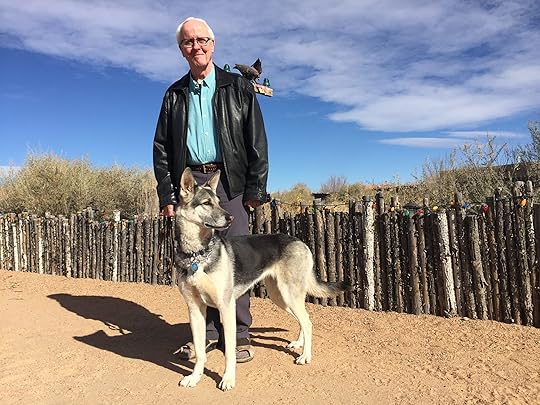 Jim Belshaw with his German Shepherd Gracie
Jim Belshaw with his German Shepherd Gracie
August 5, 2020
1LT Henry Lowenstern, U.S. Army – From Fleeing Germany to Returning in Triumph
First Lieutenant Henry Lowenstern did more than live the American dream—he earned it. After he and his family fled persecution in Germany during the 1930’s, Henry and his older brother, Leon, served in the army that helped end Hitler’s scourge. They then returned to the United States and led successful lives with their families. This is Henry’s story.
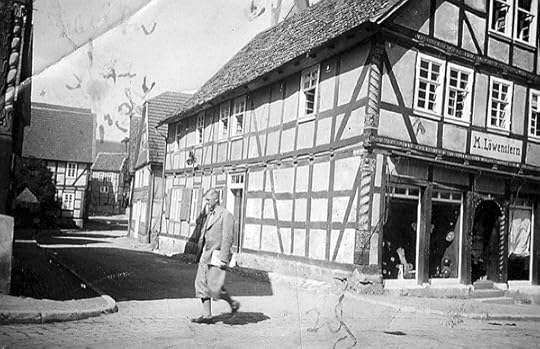 The Lowenstern family store in Korbach, Germany
The Lowenstern family store in Korbach, GermanyHenry was born in Korbach, Germany, in 1925, as Hans Lowenstern. His father ran a successful store he inherited from his own father, selling yard goods, bedding and clothing. Henry and Leon, then named Ludwig, enjoyed growing up in Korbach until Hitler was appointed Chancellor of Germany in 1933. That’s when Germany’s systematic persecution of Jews began. Initially, Henry’s parents thought Hitler was just another political hack and that he would quickly fade away, but he did not. Soon the Hitler Youth started painting on their storefront “Jews are traitors” and people threw rocks and logs through their show windows.
Henry’s father tried to prove to the town that he and his family loved Germany by copying the words from a ceremonial plaque presented to their synagogue for the ten Jewish men of Korbach, including his father’s brother, who fought and died for Germany during World War I. The inscription read “The Fatherland thanks you forever for your service.” Henry’s father displayed the inscription on a board in the store’s broken window, but the words rang hollow. In fact, Henry’s father had to go into hiding immediately after displaying the words out of fear he would be taken away. He was able to eventually return, but the situation continued to deteriorate. Henry remembers recruits for the feared Waffen SS Storm Troopers, who trained on the other side of town, marching down the street in front of his family’s store singing, “When Jewish blood spurts from the knife, things will go twice as nice.”
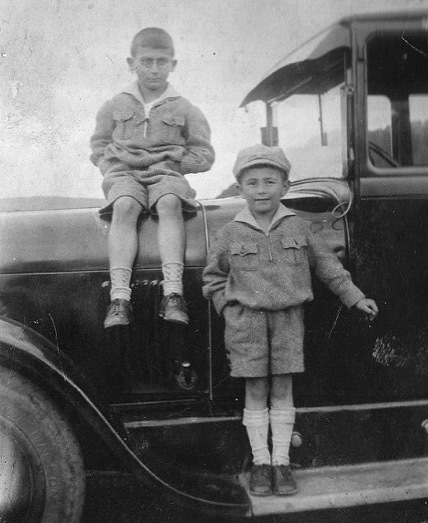 Leon (left) and Henry (right) as boys in Germany
Leon (left) and Henry (right) as boys in GermanyAmid all of this hatred, Henry’s parents knew they had to escape Germany. They were able to send Leon to live in England with one of his mother’s brothers living there. Another one of his mother’s siblings lived in America and she sponsored Henry’s family to come to the United States. Miraculously, his family was able to leave Germany in the spring of 1937 and they sailed on the SS President Roosevelt, a United States Lines ship, to America. They settled in Baltimore, with Henry’s mother and father renting a very small apartment while Henry went to live with his aunt and uncle.
Henry and his parents found the people in America very welcoming. His father took a job as a floor sweeper in a necktie factory, but after a while he stepped out on his own, buying fresh butter and eggs from farmers outside Baltimore and delivering the produce to people in the city. He started delivering only to family and friends, but word spread and his service expanded until he was able to earn enough from his route to support the family. His mother initially worked as a maid until the family got on its feet financially.
Henry immediately began attending elementary school where everyone treated him like a celebrity. He learned English quickly, changed his name from Hans to Henry, joined the Boy Scouts with his cousin, and made lots of friends. He even started earning a little money of his own by going door to door to sell the Saturday Evening Post, Ladies Home Journal, and Country Gentleman magazine. Henry became comfortable with his new life in America.
After a year of living with his aunt and uncle, Henry moved back with his mother and father, who were now well-settled. He attended high school at Baltimore City College with the Class of 1944; however, given that he had completed a number of advanced credit courses, he was able to graduate in the fall of 1943.
After graduation, Henry visited another aunt and uncle, also refugees from Germany, who had purchased a chicken farm in New Jersey with the assistance of the Jewish Agricultural Society. His job was to learn everything he could about chicken farming so his parents could buy a chicken farm, too, and he could teach them how to run it. His parents did just that and after two weeks of learning the business, Henry joined his parents on their New Jersey chicken farm and taught them everything he’d learned. He didn’t have long, though, because now that he was out of high school, he was eligible to be drafted and he soon found himself on his way to Fort Dix, New Jersey, to join the U.S. Army at the invitation of Uncle Sam.
Henry in-processed at Fort Dix but spent little time there. After about a week, the Army sent him to Fort Sill, Oklahoma, for basic training in artillery. He has positive memories of Fort Sill, noting there was a good group of officers running the training. He learned how to fire the big 105 and 155-millimeter howitzers and to drive the big trucks that hauled the guns around. He also trained to become a radio operator. Dust storms occurred routinely, normally right after Henry and his fellow soldiers finished scrubbing their barracks after the last dust storm. He also remembers that Oklahoma served 3.2% beer, which, given the reduced alcohol content, made it harder for soldiers to get out of hand. The event that stands out most, though, was when a judge visited Fort Sill and swore Henry and a few other soldiers in as new United States citizens. Just seven years after escaping Hitler’s reign of terror, Henry was prepared to risk his life to defend his new home.
Before graduating from basic training, Henry applied for Officer Candidate School (OCS). The Army approved his request and, at age 18 and fresh out of basic training, Henry began a ninety-day crash course at Fort Benning, Georgia, to become an infantry officer. He attended OCS in the fall of 1944 and finished on December 7th, just before the Battle of the Bulge raged in Europe. Infantry officer training was rigorous, especially the obstacle course. He pushed through and successfully completed the course and also qualified as a sharpshooter with the M1 carbine. The biggest challenge of all, though, was the food, which Henry describes as atrocious. He and the other officer candidates spent a lot of time at the base canteen buying snacks.
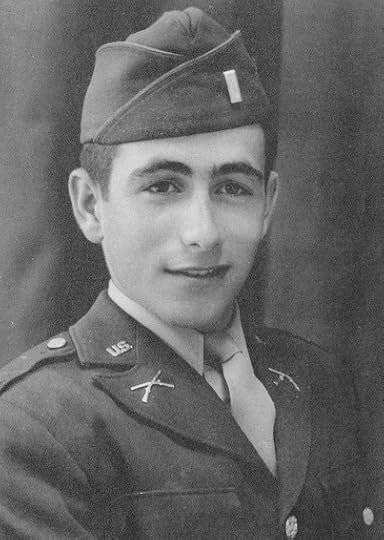 1LT Henry Lowenstern
1LT Henry LowensternWhen graduation day came on December 7th, 1944, all of the newly minted 2nd Lieutenants were told they were shipping off to fill gaps in the Army’s platoon leader ranks in Europe. All, that is, except for Henry and one other new officer because they were fluent in German. Instead of heading immediately to Europe, they were dispatched to the Military Intelligence Training Center at Camp Ritchie, Maryland, to train as interrogators.
Camp Ritchie, located in western Maryland about sixty miles from Washington, DC, was a secretive facility few knew about and the Army wanted to keep it that way. For example, to help make the Camp’s schedule unpredictable, the Camp’s commander rearranged the calendar so each week had eight days. Another example was when the nearby city of Hagerstown’s newspaper announced the wedding of a local woman, it said only that she was marrying a soldier assigned to a nearby Army camp. Henry muses that with all of that effort to keep the camp secret, matchbooks the soldiers got when they bought cigarettes at the post exchange had “Military Intelligence Training Center, Camp Ritchie, Maryland” on their cover. So much for keeping a secret!
Training at Camp Ritchie was unique. On several occasions, Henry and other trainees were loaded into a truck in the middle of the night and dropped off miles from the Camp with nothing but a small supply of food and a map written entirely in German or Japanese. Their assignment was to find their way back to the Camp, which they always did—usually with the help of local farmers. Another unusual aspect of the training was that for certain events, some U.S. servicemembers wore German and Japanese uniforms and played the roles of enemy forces to make the training as realistic as possible.
Henry graduated from the Military Intelligence Training Center in April 1945, and immediately shipped out on the French liner Normandie, which had been converted into a troop ship. After landing in Scotland, he continued on to France as part of a six-man counterintelligence team. Traveling by jeep, the team drove east through Paris and eastern France, crossing into Germany on May 5th just as the war in Europe was ending. Henry comments that when the Germans heard he was coming, they surrendered.
When Henry’s team arrived in Germany, they learned that hundreds of thousands of German soldiers had surrendered and were being held by the U.S. 3rd and 7th Armies in makeshift camps that were little more than fields with barbed wire strung around them. Their team’s job was to interrogate the POWs, as well as other Germans, to determine if they should continue to be held because they either posed a threat to Allied forces or because they had been involved in possible war crimes. They operated in the vicinity of Stuttgart in POW camps near Heilbronn, Hohenasperg and Ludwigsburg.
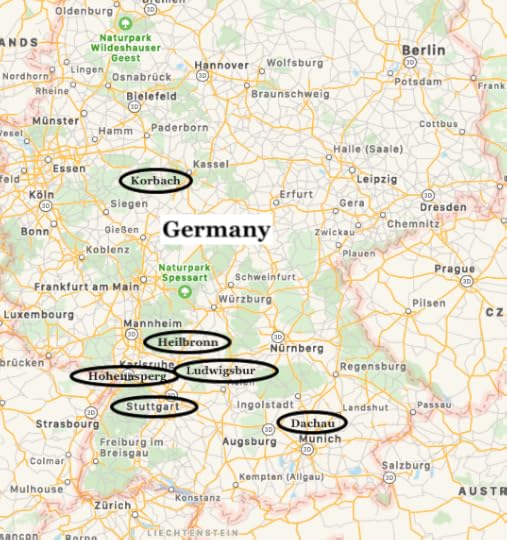 Locations relevant to Henry Lowenstern in Germany
Locations relevant to Henry Lowenstern in GermanyHenry’s interrogations often followed a familiar pattern. The subject of the interrogation would claim they knew nothing about German atrocities, including the Holocaust. They also claimed they were strongly anti-Nazi. Henry then asked why they didn’t do anything to oppose the Nazis if they were so much against them. Their reply was they couldn’t because they were afraid of what the Nazis would do to them. In other words, they turned a blind eye to the Nazi atrocities committed against Jews and others but were very much aware of Nazi methods when their own lives were at stake. Henry had experienced the horrors of the Nazi regime first-hand as a boy and again during a visit to the Dachau concentration camp just after the prisoners were liberated, so he could not be deceived. When Henry’s team finished interrogating a prisoner, they turned the results over to U.S. military officials who were responsible for addressing the findings.
One person Henry interrogated was a certain Dr. Zimmerman. Henry recognized him because he had been the mayor of Korbach when Henry lived there as a boy. While Henry remembered the mayor, the mayor did not recognize Henry. Henry took the opportunity to ask lots of questions about people, streets, and events in Korbach in great detail, never letting on that he grew up there. He is certain that when the mayor left, the mayor had to be amazed at how knowledgeable American interrogators were about people and life in his small German city.
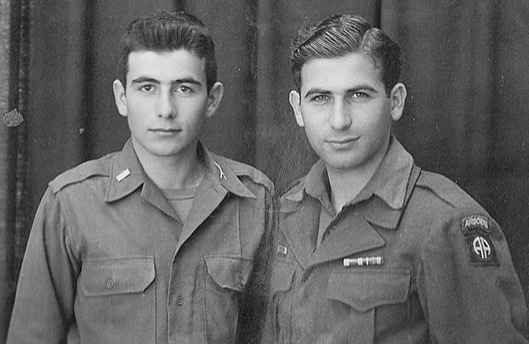 Henry (left) and Leon (right) Lowenstern
Henry (left) and Leon (right) LowensternThe locations where Henry worked had largely escaped the war’s devastation. He and other members of his team lived in a commandeered house and they hired a cook, so living was comfortable. He also rendezvoused with his brother, Leon, who fought his way into Germany with the 82nd Airborne Division, and they visited their boyhood home in Korbach together. When they visited their neighbor, Mrs. Tent, she was amazed to see them both all grown up in U.S. Army uniforms. She remarked, “What, you came back to fight against us?” perhaps not recalling the town’s hatred that forced them to leave.
By the spring of 1947, Henry was ready to return home. During his tour, he was promoted to 1st Lieutenant and, as the Army drew down, converted to a civilian interrogator doing the same job but earning more pay. With his work finished, he sailed back to the United States and joined his parents on their farm in New Jersey.
Using the GI Bill, Henry attended Rutgers University beginning in the fall of 1947, majoring in journalism. He wrote for the campus newspaper and served as president of a non-fraternity organization. He graduated from Rutgers in 1950, only to continue his education at the University of Wisconsin in Madison, earning a Masters degree in Economics in 1950. This led to his first job at the Bureau of National Affairs, which was a private publishing firm, specializing in tax, patent, and labor relations products, and had been under the U.S. News and World Report corporate umbrella.
While working at the Bureau of National Affairs, a friend told him there was someone he needed to meet. The friend arranged for them all to have lunch. At lunch, Henry met Martha, who Henry said he continued to have lunch with every day thereafter for 67 years.
Henry went on to have a long and distinguished career in labor relations. Among other positions, Henry worked for seventeen years writing for the weekly newspaper of the Machinists Union and for twenty-two years editing the U.S. Bureau of Labor Statistics Monthly Labor Review. He finally retired in 1991 as an Associate Commissioner of the Bureau. Martha had a similarly long and distinguished career, working for the International Labor Organization and the U.S. Department of Labor. Henry now writes daily verses he calls doggerel at his Alexandria, Virginia, retirement community, which has named him its First Poet Laureate.
Voices to Veterans is proud to salute 1st Lieutenant Henry Lowenstern for his distinguished service in the U.S. Army during and after World War II. His efforts in post-war Germany helped ensure that those responsible for war crimes and crimes against humanity were held accountable. Moreover, within years of immigrating to the United States, he answered America’s call without hesitation, serving in the forces that helped liberate the people of Europe from the heinous Nazi regime. We are proud of all Henry has accomplished, and we wish him fair winds and following seas.
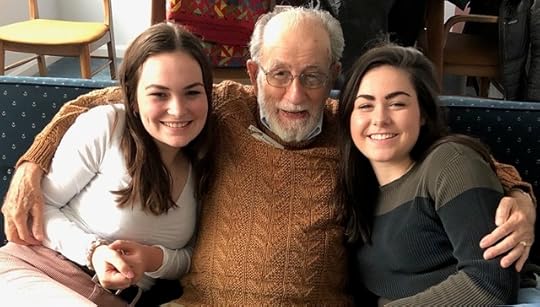 Henry with 2 of his granddaughters – Alice and Kate
Henry with 2 of his granddaughters – Alice and Kate
July 9, 2020
Colonel Hank Hoffman, U.S. Air Force (Ret.) – Welcome Home From Vietnam
What do you say to an Air Force pilot who flew 377 combat missions over the course of four different combat tours in Vietnam? How do you say thanks to a man who answered his country’s call and put his life on the line every time his aircraft took off from far away bases in Guam, Japan, Thailand and Vietnam? In Colonel Hank Hoffman’s case, the answer is simple. You shake his hand and extend to him a heartfelt “Welcome home.” Then you listen to what he has to say. This is his story.
Hank grew up in a lower-middle class neighborhood in Detroit. His father was a pilot for Eastern Airlines, but his parents divorced when he was young, so Hank drew inspiration for flying from reading science fiction. He wasn’t just interested in flying airplanes—he wanted to fly in space and be the first person to set foot on Mars. That was a tall order for a boy being raised by a mother with limited means, but he was smart and hard-working, so a door opened up for him. As he was entering the seventh grade, he earned a scholarship to the Cranbrook School in Bloomfield Hills, Michigan, which was an exclusive boarding school just north of his family’s home. The Cranbrook School prepared him well for his future, but it wasn’t always smooth sailing.
As with most boys, Hank enjoyed sports more than studying. He was an excellent middle distance runner and was the Interstate League champion in the 440-yard dash. He also lettered at soccer. What he did not excel at was memorization, not because he couldn’t, but because he wouldn’t devote time to it if he didn’t see its value. As a result, his studies suffered. Then, at the end of his sophomore year, the headmaster called him to his office and told him his scholarship was being terminated because things had changed. At the time, Hank attributed the change to his failure to reach his full potential. He later learned the changed circumstances were that his mother had re-married and they no longer qualified for a need-based scholarship.
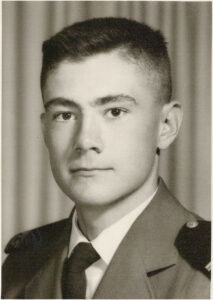 Cadet 4th Class Hank Hoffman
Cadet 4th Class Hank HoffmanHank split his junior year between two schools in Detroit, but really missed Cranbrook and wanted to return for his senior year. He begged his mother to find the tuition to send him back and she did, so he graduated from Cranbrook with his friends. He also scored extraordinarily high on his college entrance exam tests, so he was well situated to apply for college.
Although Hank had several partial scholarship opportunities, he really wanted to attend the U.S. Military Academy at West Point where tuition, room and board would all be free subject to him giving the Army six years of his life after graduation. Given his athletic prowess and college entrance exam scores, Hank believed he could get admitted—all he needed was to be nominated by his Congresswoman for a slot. When Hank visited her, she told him she had already made her nomination for West Point, but that she had a nomination available for the brand new Air Force Academy in Colorado Springs. She said he and the other interested young men would have to take a test and she would give the person scoring highest her nomination. Hank scored the highest by far, but the Congresswoman still gave the nomination to another young man, making Hank an alternate. Hank was still offered admission, however he vowed never to vote for the Congresswoman because she went back on her word.
Hank’s Air Force adventure began almost immediately after he graduated from Cranbrook School. He reported to the Air Force Academy on June 26, 1959, as part of the fifth class to attend, but the first class to actually live at the Academy for all four years in the newly finished dormitories. While the Academy was new, the military training was not—it was rigorous and nonstop. Hank and the other “doolies”, as the 4th Class cadets are called, soon found themselves running around getting haircuts and uniforms and learning who was in charge.
The next day, Hank’s flight of cadets was awakened at 5:00 a.m., an hour before physical training was supposed to begin, so they could be the first flight to run to “the rock”, a nearby mesa 7,250 feet above sea level. Being in superb shape and having just come off the spring track season, Hank made it to the top, finishing just behind the flight’s first sergeant who orchestrated the run and was captain of the cross country team. Hank went on to be a very successful runner and soccer player for the Academy, repeatedly lettering in both sports. He also graduated 41st out of the 499 cadets comprising the Class of 1963, completing 215 semester hours while still keeping up with his military duties. The famed General Curtiss LeMay, then the Chief of Staff of the Air Force, handed Hank his degree.
After graduation and a quick visit home, Hank drove his new Ford Galaxy to Williams Air Force Base, located 30 miles southeast of Phoenix, Arizona, for basic pilot training. He trained with a group of German officers who were learning to fly at the U.S. base. He remains friends with them to this day. He spent six months learning the basics in the two-seat T-37, and then transitioned to the brand new T-38 supersonic jet trainer which was fun to fly. After graduating from pilot training, he and about 60% of the new pilots headed to the Strategic Air Command, or SAC, to learn to fly the B-52 “Stratofortress” or the KC-135 tanker “Stratotanker” (for in-flight refueling). Hank was assigned to B-52s.
The B-52, affectionally known as the BUFF (“Big Ugly Fat Fella” or other expletive), has been in continuous service in the U.S. Air Force since 1955. Originally designed to carry nuclear weapons as part of America’s nuclear triad, it also proved to be a potent conventional weapon. In Vietnam, B-52s were outfitted to carry twenty-four 750 pound bombs externally on their wings, as well as eighty-four 500 pound bombs internally in their bomb bays. That meant it could deliver over 60,000 pounds of explosives with a range of 8,800 miles, and further with aerial refueling. To put this into perspective, the famed B-17 in World War II could deliver 4,500 pounds of explosives on an 800 mile mission.
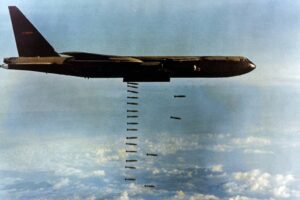 B-52 dropping bombs over Vietnam
B-52 dropping bombs over VietnamBeginning in October 1964, Hank learned to fly the B-52 at Castle Air Force Base near Merced, California. He did well at training, and particularly excelled at the difficult task of aerial refueling, which is amazing considering how he qualified. He was paired with a major who was having difficulty learning the maneuver, so the major did seven practice runs leading up to his refueling qualification check ride. This meant that Hank did not get to practice the maneuver at all—he could only watch the major and learn from his mistakes. This must have worked well because when Hank took the controls to earn his refueling qualification, he passed it on the first attempt and received a grade of Highly Qualified.
After completing his B-52 training, Hank reported to his first assignment with the 864th Bomb Squadron, 494th Bomb Wing, at Sheppard Air Force Base, just north of Wichita Falls, Texas. Now a First Lieutenant, Hank flew as co-pilot on B-52s flying strategic deterrence missions, which meant they carried nuclear weapons and had to be ready at a moment’s notice to fly missions against the Soviet Union in the event of a nuclear attack. In October 1965, Hank began to fly “Chrome Dome” missions, where his and another nuclear bomb equipped B-52 would fly to the North Pole and remain on station in case a “Red Dot” message came in directing them to attack the Soviet Union. These missions, which were in the winter and thus continually in the dark at the North Pole, lasted a grueling twenty-two hours and involved multiple in-flight refuelings.
In March of 1966, Hank shifted to the 393rd Bomb Squadron, 509th Bomb Wing, at Pease Air Force Base in New Hampshire. Then, in February of 1967, his plane and crew were sent to Anderson Air Force Base in Guam to fly combat missions in the Vietnam War. The missions were twelve hours long, required in-flight refueling, and showed little results as the planes were essentially bombing the jungle from 30,000 feet. After flying two months of these combat missions, Hank’s crew returned to Pease Air Force Base to resume their nuclear deterrent mission.
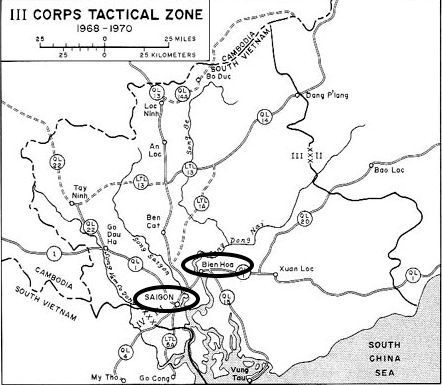 Saigon and Bien Hoa Air Base, Republic of South Vietnam
Saigon and Bien Hoa Air Base, Republic of South VietnamIn May of 1968, Hank’s plane and crew were again sent to Southeast Asia, this time flying out of U Tapao, Thailand, and Kadena Air Base on Okinawa, Japan. The advantage of flying missions out of these locations was in-flight refueling wasn’t necessary as the trips were much shorter—four hours from U Tapao and eight from Kadena—although B-52s flying from Kadena refueled anyway. Hank flew his first mission over North Vietnam on May 8, 1968, and less than one year later completed his 100th combat mission after returning to U Tapao. The crew celebrated with breakfast, champagne, lunch, beer, some sleep, and a mission the next day.
While every mission in a combat zone carries significant risk, certain missions stand out in Hank’s memory. One involved a hydraulic failure, making it unclear whether the left front landing gear could be relied upon when the giant plane touched down. Other flights involved “hung” bombs that failed to drop, so they would have to be carried back to base with the hope that they wouldn’t arm or detonate at the wrong time. On one such occasion, three 500 pound bombs were hung up in the bomb bay. Sometime after the bomb bay doors closed, the three bombs released and fell onto the closed doors. After landing, Hank and his crew quickly evacuated the plane so the ordnance crew could take care of them. On another flight, the crew detected unexpected enemy anti-aircraft fire at 40,000 feet, but fortunately they weren’t hit. Other crews weren’t so lucky, with planes suffering catastrophic structural failures and the loss of everyone on board. Hank and his friends described their missions as hours of boredom interrupted by moments of stark terror.
After five years as a co-pilot and having to re-acquaint more senior pilots from the Pentagon with the B-52’s flight controls, Hank decided it was time to return to civilian life. As soon as he made his intentions known, his Wing Commander told him he’d finally been approved to transfer to fly F-4 jet fighters—all he had to do was pull his resignation papers. Since Hank had always wanted to fly fighters, he accepted. When he received his orders, they weren’t for the F-4 as promised, but for the A-37 “Dragonfly”. He didn’t complain, though, because this was his chance to get into the cockpit and fly something more fun than the B-52. Nonetheless, his record in the B-52 was impressive. He’d flown 172 combat missions over the course of three tours in Southeast Asia, amassing over 3,000 B-52 flight hours, 1,300 of which were during combat missions.
Unlike the B-52 which flew missions at 30,000 feet, or 40,000 feet when over North Vietnam, the A-37 flew attack missions at 1,500 to 2,500 feet in direct support of U.S. ground forces. The aircraft could carry high-explosive bombs, cluster munitions, rockets, napalm, and bullets. It could attack enemy units closer to friendly forces and with much greater accuracy than faster flying fighters, and because its ordnance delivery speed was in the 300 miles per hour range, it could turn and maneuver with precision. As a result, A-37 services were much in demand.
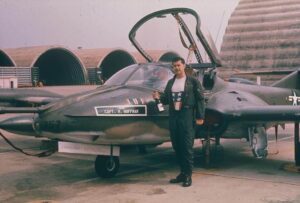 Hank celebrating after his last A-37 combat mission
Hank celebrating after his last A-37 combat missionThe demand likely accounted for Hank’s quick training pipeline and return to Vietnam. After training stops at Myrtle Beach Air Force Base in South Carolina and England Air Force Base in Louisiana, Hank was back in Vietnam by the end of May 1970. He was assigned to the 604th Special Operating Squadron (SOS), which later became the 8th SOS, at Bien Hoa Air Base located about sixteen miles from Saigon. In the first nine days after arriving, he flew seven combat missions, which was actually a light schedule since he would later fly up to three combat missions in a day. Quarters were scarce, so he was initially given the room of a lieutenant who was recuperating in Hawaii after being hit by ground fire during a flight. The lieutenant’s bloody parachute harness with a bullet hole in it hung on the door—a stark reminder of the deadly serious business Hank was getting into. Thumps at night outside the “hootches” from mortars fired by the Viet Cong reinforced the point.
Hank flew close air support missions nearly every day. On September 22, 1970, one such mission nearly cost him his life. He was rolling in from 12,000 feet to bomb some boats on the Mekong River when the forward air controller asked if he could strafe the boats with machine gun fire and drop napalm and cluster munitions on a subsequent run. Hank had never done that before but wasn’t aware of any prohibition, so he started throwing switches and getting his guns ready. Coming in low and with his sights on the lead boat, he pulled the trigger only to find he’d forgotten the Master Arm switch. Instead of pulling out of the attack as he should have, he armed the guns and fired directly into the last boat. Thrilled he’d scored a direct hit, he pulled back on the stick and gave the engines full throttle to pull out of his dive. The A-37’s nose came up, but the plane kept heading down toward the water—he hadn’t factored in the extra weight of the ordnance he normally would have expended before doing a strafing attack. His wing nearly hit the mast of the boat he’d attacked and just when his plane was ready to hit the water, the ground effect kept it from bottoming out and he was able to climb back to altitude and resume his attacks. In explaining how he managed to cheat death, he simply says sometimes it’s better to be lucky than good.
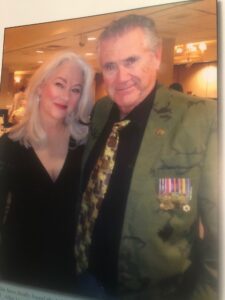 Hank and Nancy Hoffman
Hank and Nancy HoffmanHank would go on to fly a total of 205 combat missions in the A-37, becoming so accurate with his weapons that he’d put bombs in the mouth of a Viet Cong cave and through the windshield of an enemy truck hiding under a tree. He flew night missions and missions into Cambodia and, when combined with his B-52 tours, amassed a total of 1,605 combat flying hours and earned 2 Distinguished Flying Crosses, 19 Air Medals, and 8 stars on his Vietnam Service Medal. After flying his final combat mission on February 17, 1971, it was time to go home.
Toward the end of February 1971, Hank returned to the United States. After completing graduate school at the University of Arizona and earning a degree in Industrial Engineering, he went to Test Pilot School at Edwards Air Force Base in California. Over the next eleven years, he flew every type of airplane, including fighters, bombers, transports, tankers, trainers, and even gliders. Milestones during these years included launching the first two cruise missiles from a B-52 in 1979 and conducting in-flight refueling testing on the new C-141B “Starlifter” transport. He was qualified on four different aircraft: B-52s, C-141s, F-4s and KC-135s, something most pilots never get the chance to achieve. These years tested Hank’s flying skills in other ways, too, like when he had to do an emergency landing of a fuel-heavy B-52 with a severe fuel leak in its left wing. He repeated the heavy landing one month later when the same B-52 suffered an engine failure at the plane’s maximum weight of 488,000 pounds. Hank also served as an instructor pilot, passing along what he learned over the years to less experienced pilots.
When Hank reached eighteen years on active duty, he left the active Air Force and worked as a civilian KC-10 test pilot and later as a pilot for American Airlines. On one American Airlines flight from New York to Miami, former president Richard Nixon was a passenger in first class. Hank went back to meet him and get his autograph, mentioning he had worked for the president in Vietnam. President Nixon told him “the war ended poorly, but we needed to be there.” He then took Hank’s address and later sent him an autographed copy of his book, No More Vietnams. Hank retired from American Airlines in 2001. Throughout his time with American Airlines, Hank continued to fly in the Air Force Reserves, retiring as a full colonel. When it was all said and done, Hank had flown over 10,000 hours in the military and another 8,000 in the private sector, for an incredible total of over 18,000 flight hours.
Now fully retired, Hank lives with his wife, Nancy, in Colorado. He still finds time for volunteer work, as well as speaking to cadets at the nearby Air Force Academy. His advice is simple: life is short so enjoy the ride and leave things better than you found them. These are words we can all live by.
Voices to Veterans is proud to salute Colonel Hank Hoffman, U.S. Air Force (Retired) for his years of dedicated service to our country. He did his duty under the most arduous wartime conditions, saving countless American and allied soldiers on the ground by bombing enemy targets and providing precision close air support. He continued to serve unselfishly as a test pilot and flight instructor. Welcome home, Colonel Hoffman, and thank you for all you have done for our country.
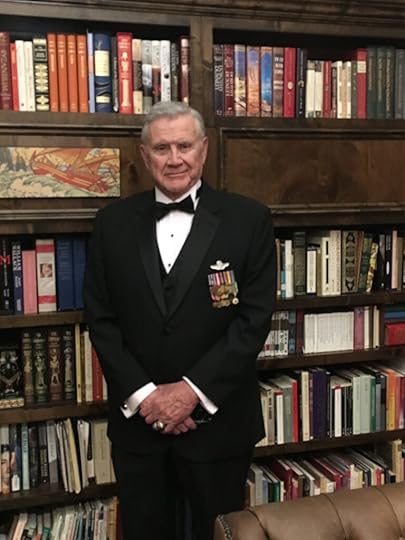 Colonel Hank Hoffman, U.S. Air Force (Ret.)
Colonel Hank Hoffman, U.S. Air Force (Ret.) June 10, 2020
PFC Robert F. Burgess, U.S. Army – From the Italian Alps to Meeting Ernest Hemmingway
I find it amazing how one small event can change the entire course of a life. For Private First Class Robert F. Burgess, U.S. Army, that moment came in 1946 when his grandmother told him to check with the Grand Rapids draft board before heading to California with his friends. One year later, instead of sailing the high seas in faraway places, Bob found himself in the Italian Alps dealing with German prisoners of war, spying on Tito’s army, and guarding an ammunition dump nine miles long and four miles wide. The life he envisioned for himself was changed forever. This is his story.
Bob Burgess was born in 1927 and grew up in Grand Rapids, Michigan, during the Great Depression. Despite what one might think, he and his buddies didn’t understand what it meant to be poor because that was all they knew. They played outdoors as long as they were allowed and made their own toys of scrap wood. Bob even earned 10 cents a week doing his chores. That magnificent amount of money in those days bought him a hamburger or took him to the Saturday matinee at the local theater.
Bob had a surprisingly normal childhood and quickly learned to sail at his grandparents’ cottage on Spring Lake. As a teenager who liked to read about deep-sea divers diving for treasure, he was anxious to get underwater and see things for himself. Ten years before Jacques Cousteau liberated America’s would-be divers with his self-contained Aqua-Lung, Bob found his own way into the underwater world. At Spring Lake in 1944, he built a diving rig out of a gasoline air compressor, 50 feet of gas station air hose and his father’s World War II Air Warden’s gasmask to dive to a shipwreck in 30 feet of water. He found the ship’s mast festooned with angler’s fishing lures lost over the years. Those lures and old iron parts of the burned wreck were proudly salvaged as his first treasure. He also came up with a cut knee from a corroded deck spike and bleeding from his ears because he knew nothing about what air pressure could do to divers’ ears if they didn’t know how to prevent it underwater.
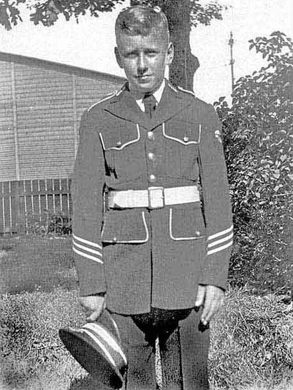 Bob in his high school band uniform
Bob in his high school band uniformBob’s mother and father were both gifted musicians, a talent they hoped to pass on to Bob by having him take clarinet lessons. He soon became quite good. Although he was only twelve years old attending Lexington Grade School, when the high school band director heard him play a solo, he arranged for Bob to get out of Lexington early several times a week to play with the Union High School marching band. In high school, Bob played first chair clarinet in both the band and the orchestra. He graduated in 1945, just as the war in Europe was ending and World War II was drawing to a close.
After high school, Bob had his heart set on doing medical research. He entered Grand Rapids Junior College and took pre-med classes. To earn money over the summer, he worked as the head dishwasher on the Milwaukee Clipper, a passenger and car ferry that ran continually across Lake Michigan between Muskegon, Michigan, and Milwaukee, Wisconsin. When the season came to an end on Labor Day, he and some of the other members of the crew planned to head to California and hire on as crewmembers with the Matson Lines, passenger ships cruising to Hawaii and the far reaches of the South Pacific. But first Bob had to go back to Grand Rapids to pick up some clothes.
Bob lived with his grandmother at the time and when he told her his plans, she said he better check with the Grand Rapids draft board to make sure he was cleared to go. Bob did as she suggested, but the draft board told him he should not go because he was certain to be called up in the next draft.
Rather than being drafted into a service without any choice, Bob and a friend decided to take matters into their own hands and enlist in the regular Army. Given his love of the water, he really wanted to enlist in the Navy, but the Navy required a 4-year contract, while the Army only required 18 months. Plus, if he joined the regular Army and didn’t wait for the draft, he could choose what he wanted to do. So, in October 1946, he and his buddy joined the regular Army. Bob asked to be trained as a medic, thinking he might be stationed in a large hospital where he could get some good medical experience.
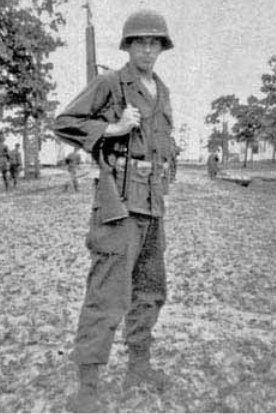 Robert Burgess at Fort Polk in 1946
Robert Burgess at Fort Polk in 1946The Army sent Bob to Camp Polk (later Fort Polk), Louisiana, for his basic training. Much to his chagrin, the next draft never came. He “was in the Army now and not behind the plow” as the lyrics of a popular song in those days went. Still, Bob enjoyed the military training he received. Since his family members were devoted hunters and fishermen, he was no stranger to handling weapons. On the rifle range he quickly qualified as an expert on the M1 Garand rifle.
Bob’s memories of Camp Polk are of long-needle pine swamps and lots of Louisiana mud, with a few coral snakes tossed in for good measure. The town near the camp where soldiers went on liberty had little to offer other than bars, liquor stores, and prostitutes, so when Bob and his buddy got a weekend pass, they bused to Shreveport hoping to meet a couple of nice girls. His buddy said they would find them in church so that’s where they went on Sunday. The pastor was so pleased to see the two uniformed fellows that he embarrassed them by asking them to stand and introduce themselves to the congregation. A kind family invited them home for a scrumptious dinner and introduced them to their two daughters. Then it was back to marching in the mud and other fun things that most soldiers never forget.
As his basic training was winding down, Bob learned his outfit was to be shipped overseas to Italy where they would be working in medical dispensaries handing out Pro Kits and information soldiers needed for coping with sexually transmitted diseases. Since that didn’t sound as though it would further Bob’s medical career, he checked to see what other options were open. Only two turned up: paratroopers and ski-troopers. Since Bob had skied all his life, the ski troopers sounded like his best bet.
The Army granted Bob’s request and he was assigned to Charlie Company, First Battalion, 351st Infantry Regiment of the 88th Blue Devil Division ski troops. Bob sailed in a Liberty ship from Camp Kilmer in New Jersey to Leghorn (Livorno) in northern Italy, where the harbor was choked with scuttled ships left over by the departing foe. From Leghorn, he and his cronies were trucked northward into the snow and ice country of the Italian Alps. Their destination was the tiny mountain town of Tarvisio, located near the Italian, Austrian and Yugoslavian border crossing, where winter already had a deep freeze lock on everything.
After brief training in Tarvisio, Bob’s company took over the border outpost checkpoint for people who passed from one country to the other. The outpost consisted mainly of several Quonset huts and a stucco building. Squads from the outpost ran snowshoe patrols along the border watching for illegal crossings of potential war criminals. Beside the border outpost was Mount Kapa, where the Americans had a tent outpost on its summit. A horse-drawn sledge carried supplies up the mountain to the outpost, where the men’s duties consisted mainly of crawling out on a snow ledge with binoculars to spy on the Yugoslavian troops billeted across the border. They also reported on the direction of aircraft flying from the Yugoslavian position.
Many of the mountains were honeycombed with gun emplacements and living quarters for the German troops that had been billeted there. Exploring one of them, Bob found a huge barracks room hewn out of solid rock and filled with metal bunk beds and discarded German helmets. Bob’s company even had a contingent of prisoners of war that worked for them and they all became friends with each other.
Charlie Company’s next assignment after outpost duty was to prepare for becoming a spit and polish contingent of the Trieste United States Troops (“TRUST”) garrison. Bob had no way of knowing it beforehand, but Northern Italy had become a major front in the Cold War between Western democracies and Eastern communism. The focal point was the city of Trieste on the Adriatic Sea, located in the northeast corner of the Italian “boot”, sitting in between occupied Italy and communist Yugoslavia. Peace was maintained by dividing Trieste into two zones, one administered by Yugoslavian forces led by Marshal Josip Broz Tito and the other administered by British and American forces. Bob and Charlie Company became part of the newly formed TRUST garrison of 5,000 U.S. soldiers.
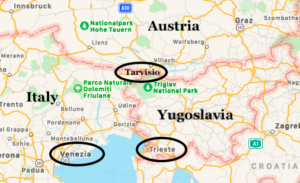 Map of Northern Italy and Trieste
Map of Northern Italy and TriesteBob’s TRUST assignment began with training on Lido Island near Venice during the early part of 1948. After approximately one month, Bob’s unit trucked to Trieste, arriving in the middle of the night with the sky completely lit up by blue searchlights. They were not looking for aircraft. Instead, they were illuminating a heavily guarded ammunition dump that was nine miles long and four miles wide on nearby Mount Opicina. Yugoslavia strongly desired the munitions.
Bob’s unit billeted in a large stone barracks on Opicina. Apparently, it was once occupied by German soldiers because Bob found several German medals when policing the courtyard area. He guessed they had been thrown away when the enemy abandoned the area before Allied troops arrived. For a week, Charlie Company took turns with other companies guarding the massive amount of explosives collected and stored there from other parts of Italy after Allied combat troops went home. Such things as plastique (a malleable explosive) were stacked in open-ended Quonset huts. Guards did not walk their posts because they were told to shoot anything they saw move. The other order was to never use their helmet’s chinstrap because nighttime intruders had broken necks by jerking a guard’s helmet back. A high barbed wire fence surrounded the dump and at night, Browning Automatic Rifle (BAR) squads outside the wire stood ready for someone or something to trip their flares. Whenever a flare went off, the BARs sprayed the area with bullets. Wild animals were often to blame.
After political tensions surrounding Trieste eased, Bob’s experience in Italy became more enjoyable. He was even able to transfer to the Army band located across the parade ground of the caserma when they learned he could play the clarinet. The warrant officer in charge arranged for Bob’s transfer and Bob played with the band for the remainder of his time in Trieste. Eventually, the band was billeted in a small hotel overlooking the Adriatic Sea and life was good. As a result, Bob’s Army tour ended on a high note, with plenty of good food, lots of time to explore the area, and even a beautiful new girlfriend named Carmen. She spoke no English, but Bob was eager to learn Italian.
Bob returned to the United States on a troop ship in 1948, landing in New York City. He had to travel across the country to Fort Lawton, Washington, to finish out his Army service. He was finally discharged after he completed his 18-month enlistment, and rendezvoused with Bob Hjellum, an Army buddy from his assignment in Trieste. After planning what they hoped would be the adventure of a lifetime, they caught a passenger ship to Italy and made their way back to Trieste as civilians. The military police in Trieste often stopped them for being out of uniform. None of them believed that Bob and his buddy had actually returned to Trieste on their own.
Using benefits they earned as veterans under the GI Bill, Bob and his friend enrolled in a language school in Trieste and spent the summer studying French. Following the Berlitz method, French was all they heard. They associated words with pictures. “Cette couleur est rouge,” and the teacher pointed to red in the Berlitz book. They soon understood the meaning of the words and that was the beginning. They also shared a one-room apartment and lived off the $75 subsistence allowance they received each month from the GI Bill.
In October, the two men moved to Neuchatel, Switzerland, to continue their studies in French at the University of Neuchatel. They shared a rooming house with other foreign students who spoke only French. Before long, they were not only fluent in the language, but they also began thinking in French. Despite barely having enough money to live off of, they managed to travel to Paris and other cities, and even made it back to Trieste. When Bob’s friend married the woman he’d been dating in Trieste, Bob headed off on his own.
That spring, Bob and a fighter pilot buddy named Fred Klaus were heading to North Africa when halfway down the boot of Italy they decided to visit the Isle of Capri. Everyone was so happy peacetime had arrived that Capri was still celebrating the end of the war. Bob and Fred rented a villa beside the sea for a dollar a day—the rent was so cheap because of the steep path down the face of a cliff that visitors had to use to reach it. They stayed in Capri for the next three and a half months. After a wonderful summer on Capri, they returned to Switzerland to finish their studies at the university. Then, after living for a time in Paris, Bob returned to the United States in 1950 to study journalism at Michigan State University.
After Michigan State, Bob set off to start his writing career with an Atlanta advertising firm. When that opportunity evaporated before he could even start work, he took a job on a U.S. Government Engineer survey crew to pay the bills, but in the evening he started writing freelance articles at home. After his writing began to take off, he left his job on the survey crew for a stint as an editor for Florida Outdoors magazine, but soon returned to freelance writing. Now writing full time and with money starting to come in, he married the woman he’d been dating ever since joining the survey crew, Julie Ann Scarborough, in June of 1956.
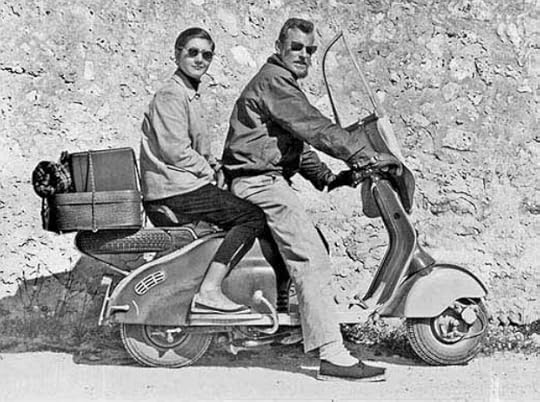 Robert & Julie Burgess on their Riviera tour.
Robert & Julie Burgess on their Riviera tour.Bob’s marriage to Julie started yet another European adventure. Bob wanted to show Julie what he learned to love about Europe, so in September 1956, they sailed on a passenger liner from New York to France. From there they traveled to Neuchatel, Switzerland, in time for the wine festival and to meet up with Bob’s old friends. As the winter snows arrived in Switzerland, Bob and Julie took a train south to sunny Italy. Wanting a new adventure to write about, they bought a Lambretta motor scooter in Milano, Italy, shipped their heavy baggage to Spain, and started across the Riviera. No one took them for Americans because American tourists never traveled that way.
Five hundred miles later, chasing the sun, they reached Spain and caught a ferry for the Balearic Islands, halfway to Africa. This was dictator Francisco Franco’s Spain and for Americans abroad, it was incredibly inexpensive which, of course, was one of the reasons Bob and Julie were there. For thirty dollars a month they rented a villa overlooking the Island of Majorca’s popular swimming beach. Other American friends moved into the area and enjoyed life where the local Champagne was 50 cents a bottle and life was good. And, since the islanders’ language was a mixture of Italian, French and Spanish, they managed to communicate easily.
The following spring, Bob and Julie took a ferry to Valencia and motor-scootered northward to Madrid where they again enjoyed the lovely exchange rate that enabled them to have a nice downtown apartment for the equivalent of $30 a month. Bob was writing for local magazines in Spain and England while sending home travel articles to American magazines. Julie got a secretarial job at the U.S. Torrejon Air Base in Madrid and the couple spent the next three-and-a half years living and traveling through Spain and other countries in Europe.
While in Madrid, Bob met an American in the Air Force who wanted to go to North Africa to find a fortified mountain in Tunisia where his brother had fought a major battle. On April 1, 1959, Julie and the other man’s wife drove Bob and his friend to the outskirts of Madrid with their backpacks and they hitchhiked and boated to Majorca, then to Marseille, then to North Africa on a ship with the French Foreign Legion. Finally, they found and climbed Hill 609 and returned to Madrid a month later. The trip cost each of them $100 and Bob’s story appeared in magazines and books he wrote. When they were in Tunisia, people seeing them in their rough army clothes and beards waved and called “Castro!” because they looked like Fidel Castro’s ragtag bearded Cuban soldiers. No one ever guessed they were Americans.
Back in Madrid, a Dutch photographer friend of Bob’s told him, “You just missed seeing Ernest Hemingway. He was on his way to Pamplona.” Bob seized the opportunity and proposed to his editor that he cover Pamplona and Hemingway for one of his magazine stories. Bob’s editor told him to go get it, so Bob grabbed his camera, a sandwich, and his leather bota of wine and motor-scootered into the Guadarrama Mountains 250 miles away. The next morning, he was in Pamplona and the fiesta was in full swing. He saw Hemingway surrounded by people and Bob knew he could not get close to him. So, he continued to photograph the running of the bulls for his magazine story.
The next day, Bob was going into the bullring and was looking at his ticket to see where he had to go when he realized Hemingway was right beside him doing the same thing. They spoke together. Bob mentioned that during his recent trip to North Africa, no one thought they were Americans. Hemingway wanted to hear about Bob’s adventure, so after the bullfight Hemingway came striding up through the stands to talk with Bob. It ended with Hemingway inviting him to come meet the rest of his mob, so for the next two days they drank together while Bob snapped photographs and later wrote about it for his book, Hemingway’s Pamplona, Then and Now.
Bob continued his amazing life after he and Julie returned from their European travels. They settled in Chattahoochee, Florida, where Bob wrote freelance articles for sporting magazines, dove on shipwrecks off the coast, and wrote novels. For the next 20 years, he also wrote sport fishing and diving stories for Florida Sportsman Magazine. Even today, well into what others would call retirement, Bob remains a prolific writer, writing books about snipers and other soldiers in the Vietnam War that have won him praise from the family members of those who served. In fact, in writing Bob’s story, I consulted his book Sailing to Adventure, The Time of Our Lives, and found his life story so fascinating, that I just couldn’t stop reading! I encourage you to read Sailing to Adventure, The Time of Our Lives so you can experience Bob’s extraordinary life through his own words. You can find Sailing to Adventure, The Time of Our Lives and all of Bob’s many books on his author page on Amazon.
Voices to Veterans is proud to salute Private First Class Robert F. Burgess, U.S. Army. His distinguished service in northern Italy and as part of the TRUST garrison helped ensure freedom for the people of Trieste and bring stability to the region in the aftermath of World War II. Even today, Bob continues to serve military families by writing about the deeds of U.S. servicemembers. We truly wish Bob fair winds and following seas.
Note: Photographs included in this story were used with the permission of Bob Burgess. Bob also kindly collaborated in writing portions of the story.
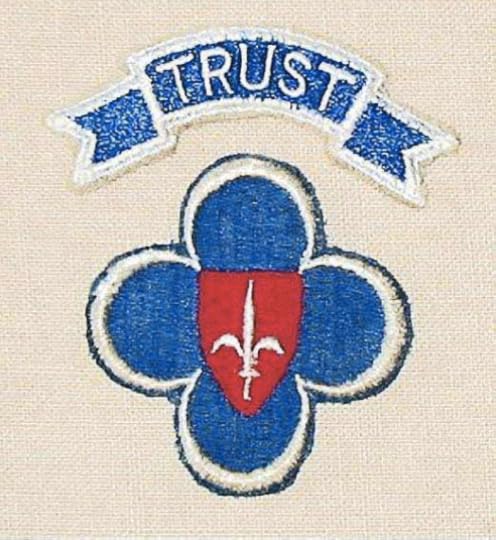 Trust Shoulder Insignia
Trust Shoulder Insignia



